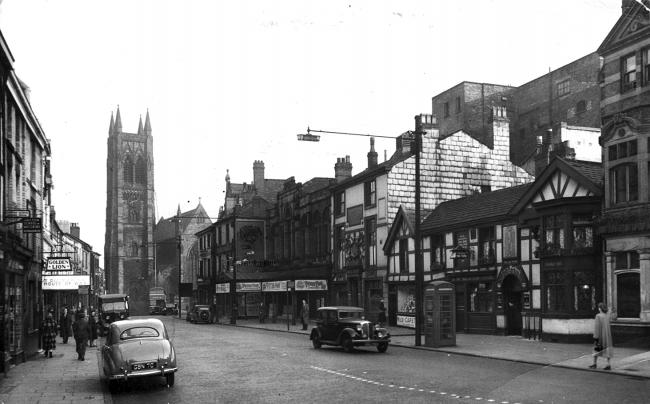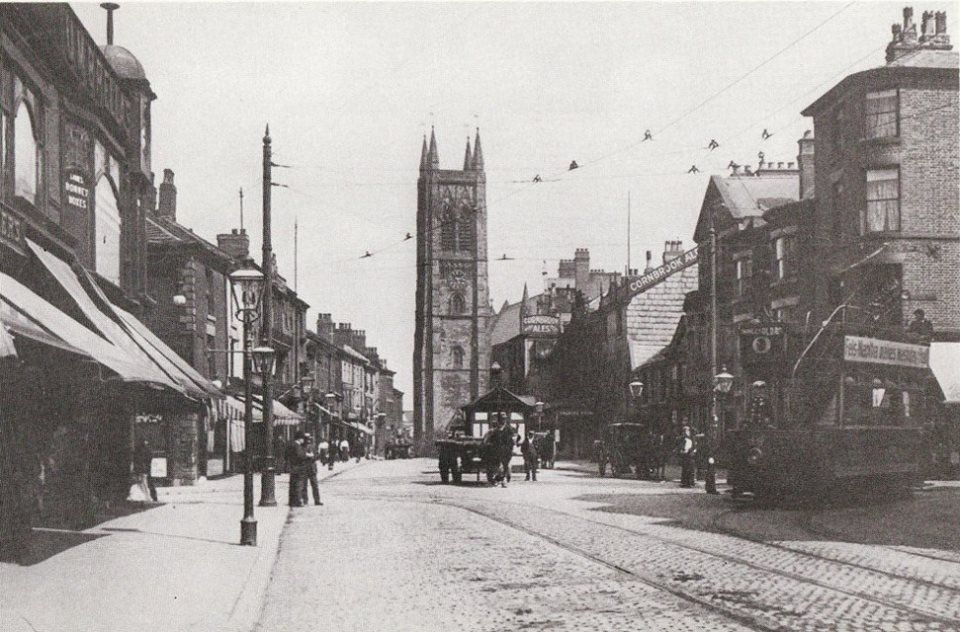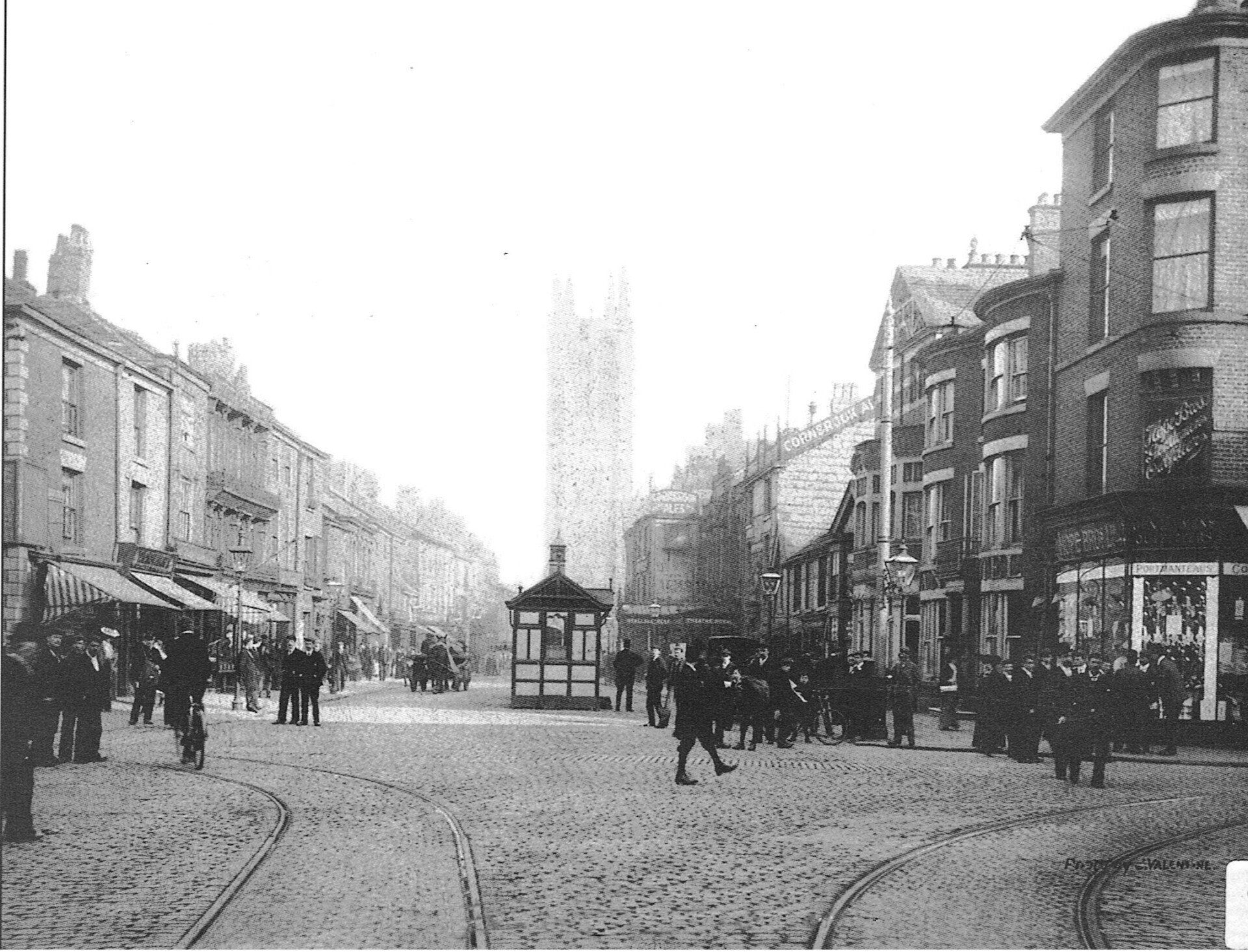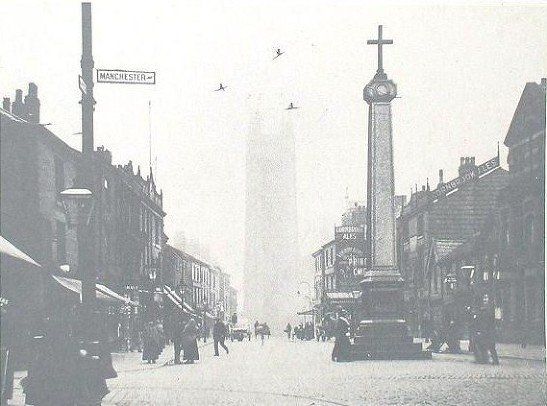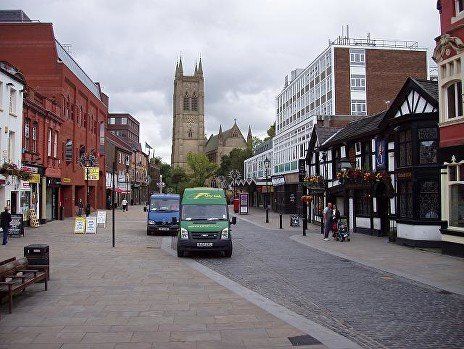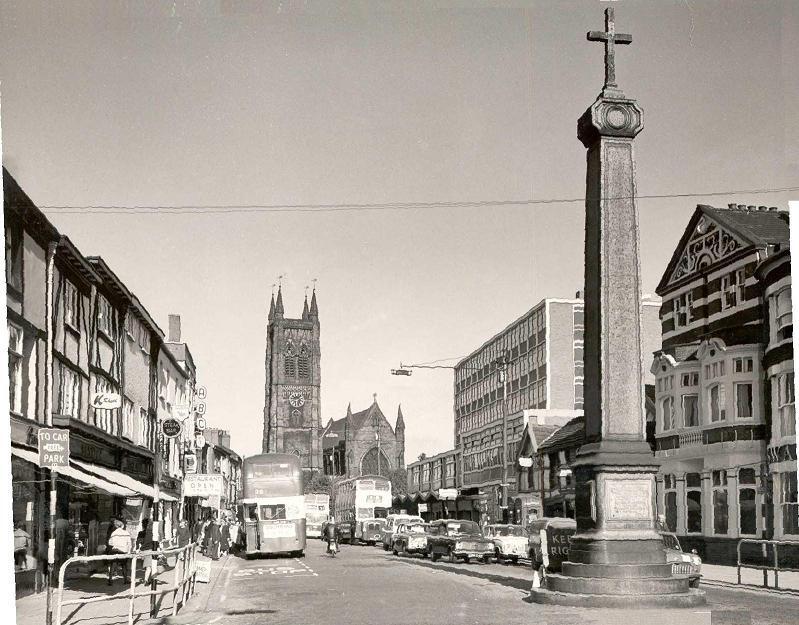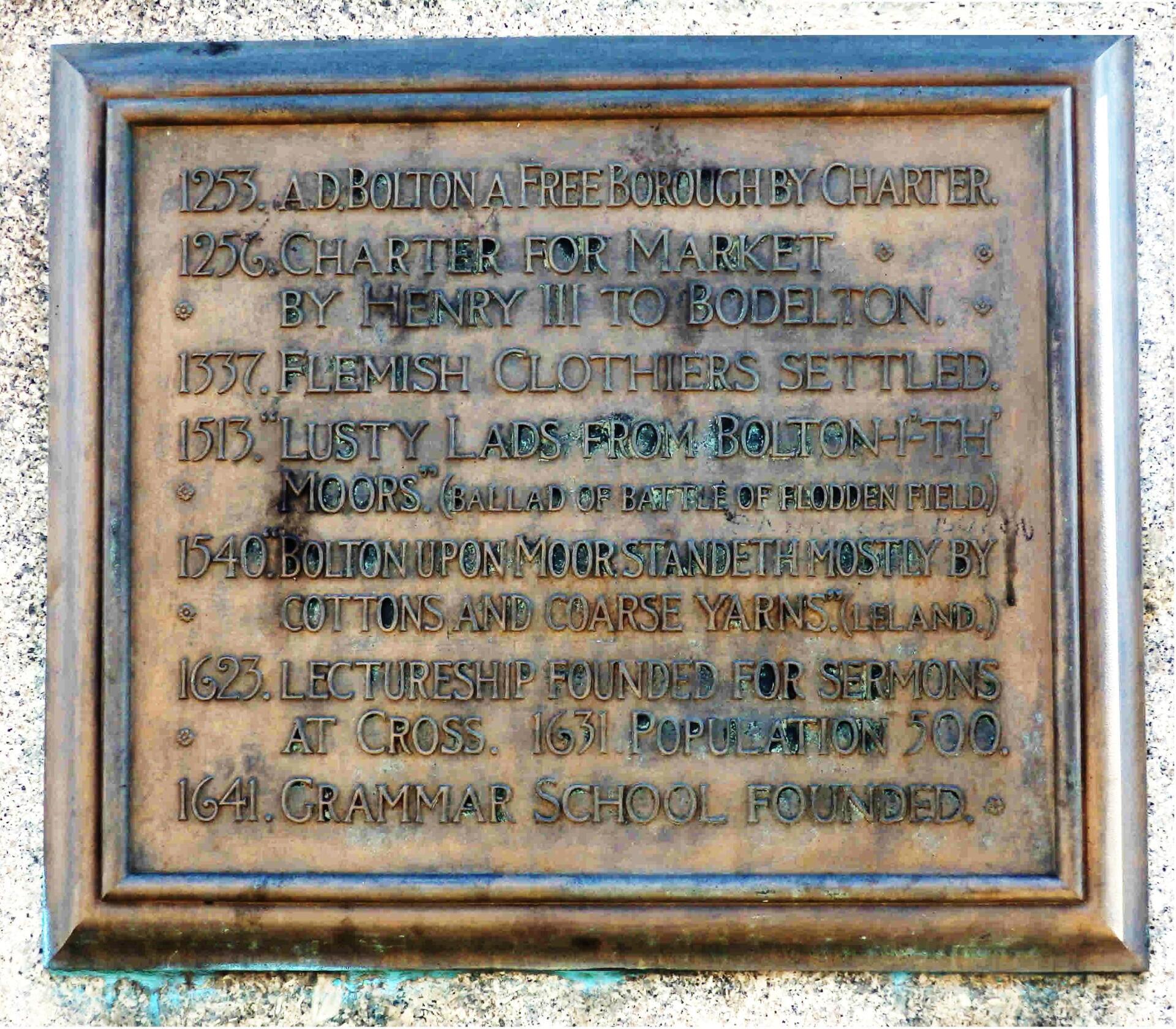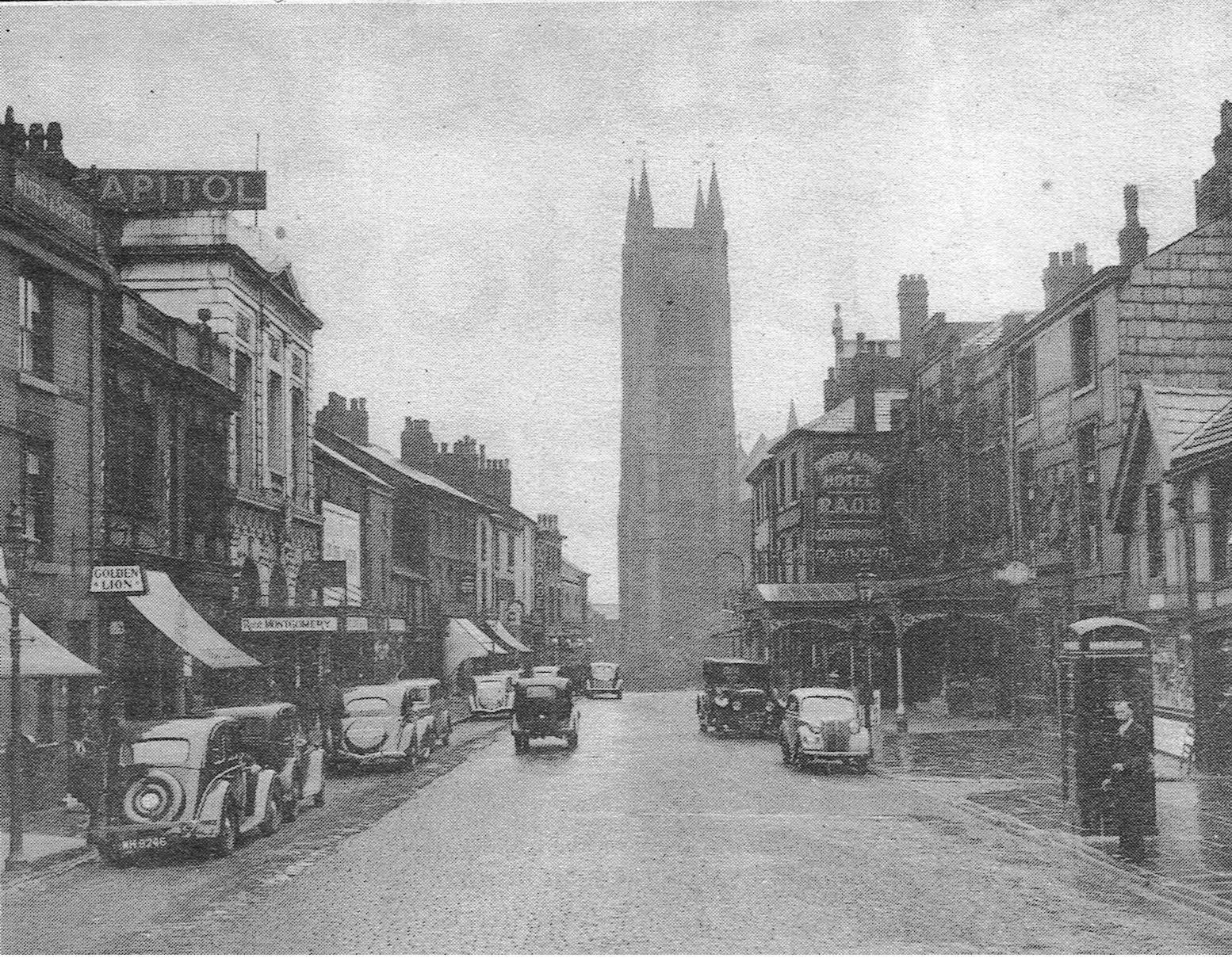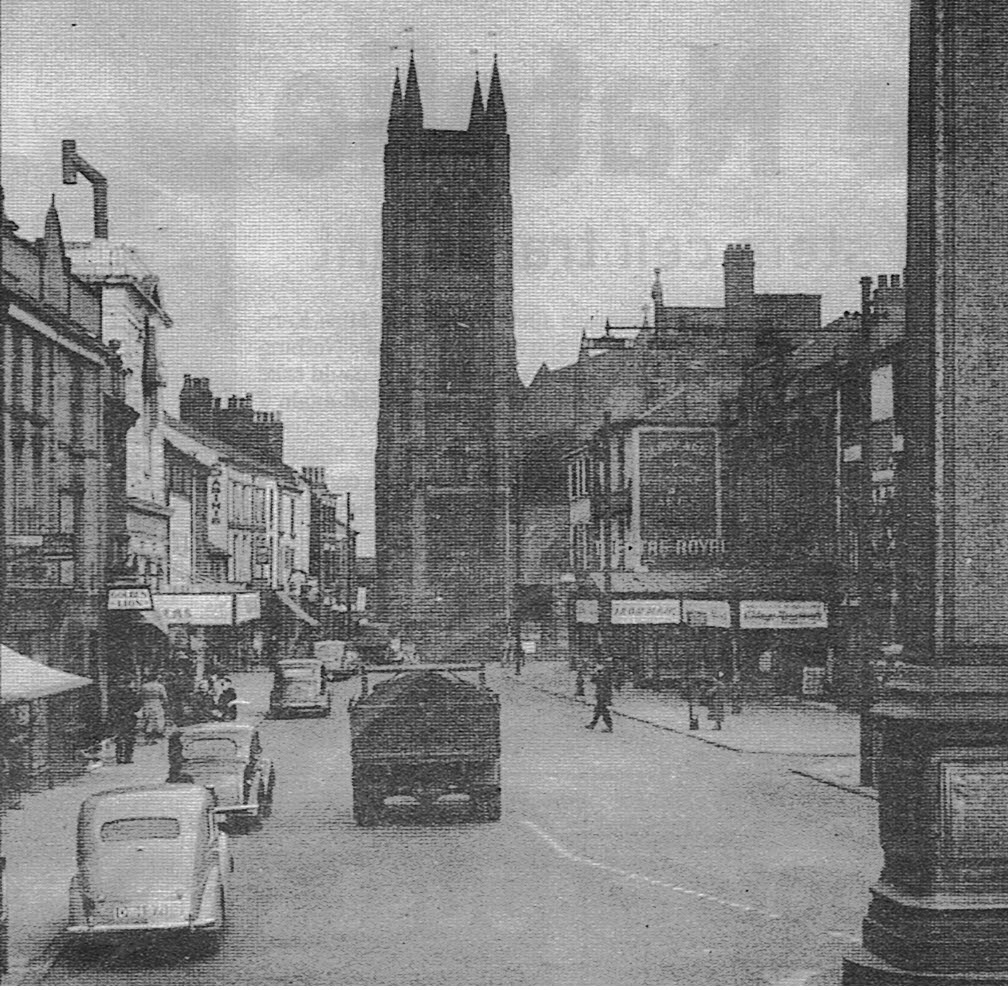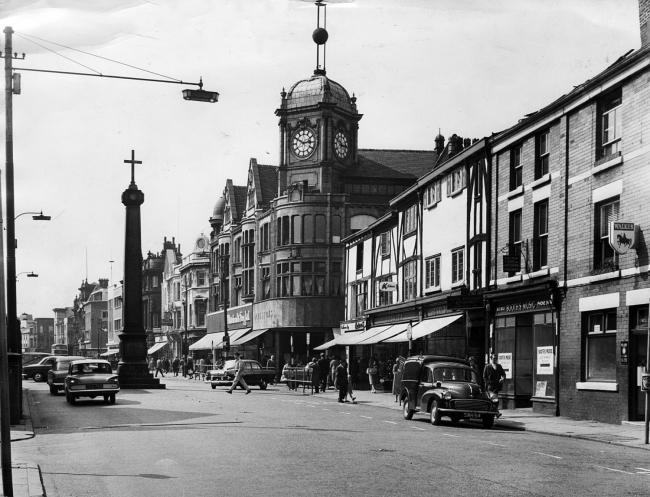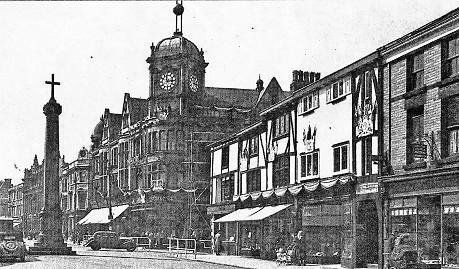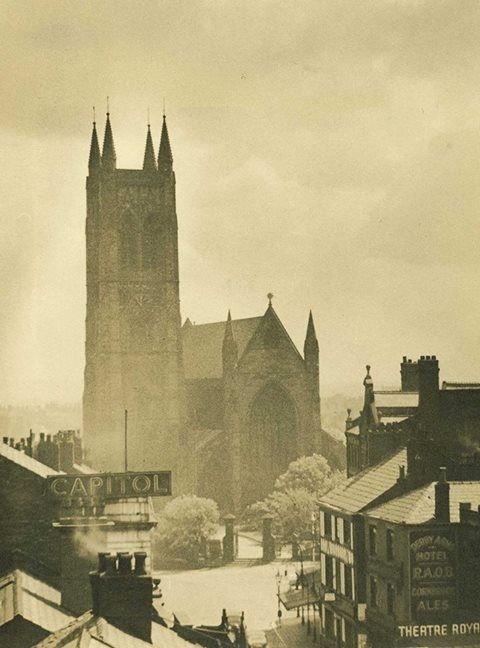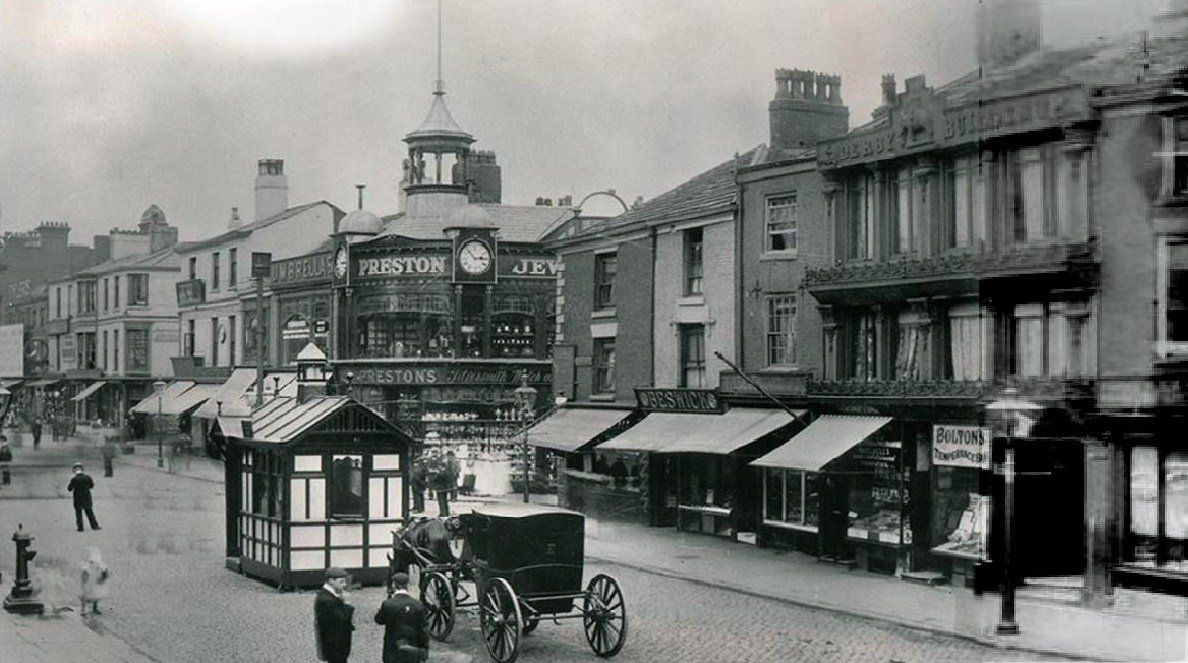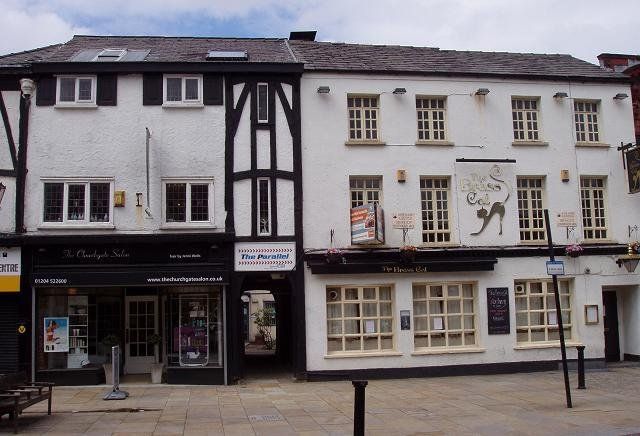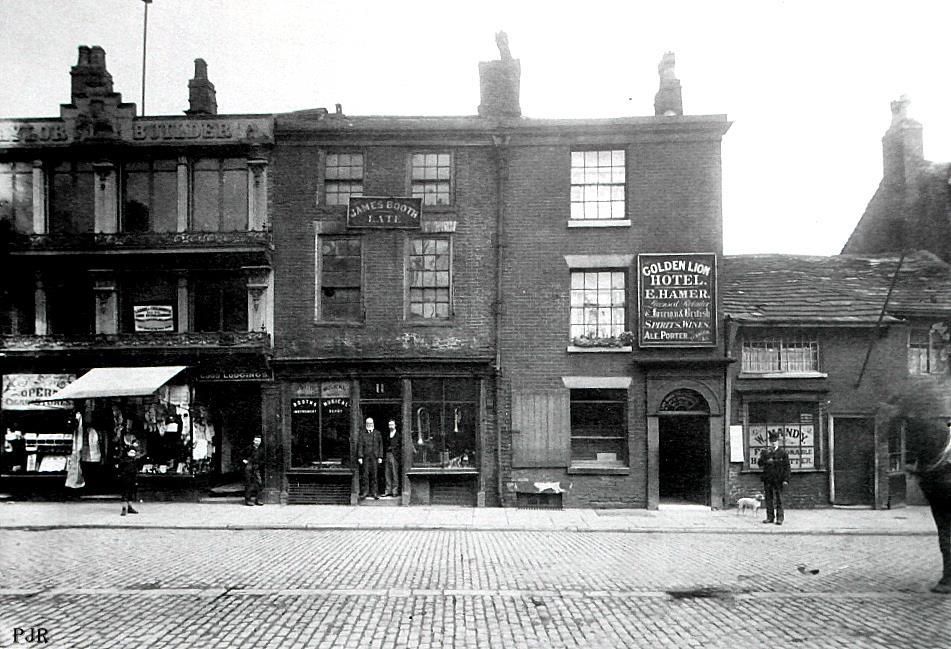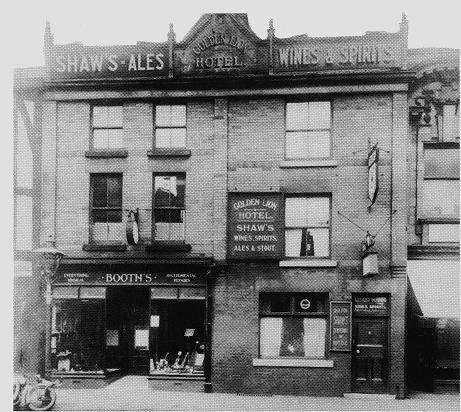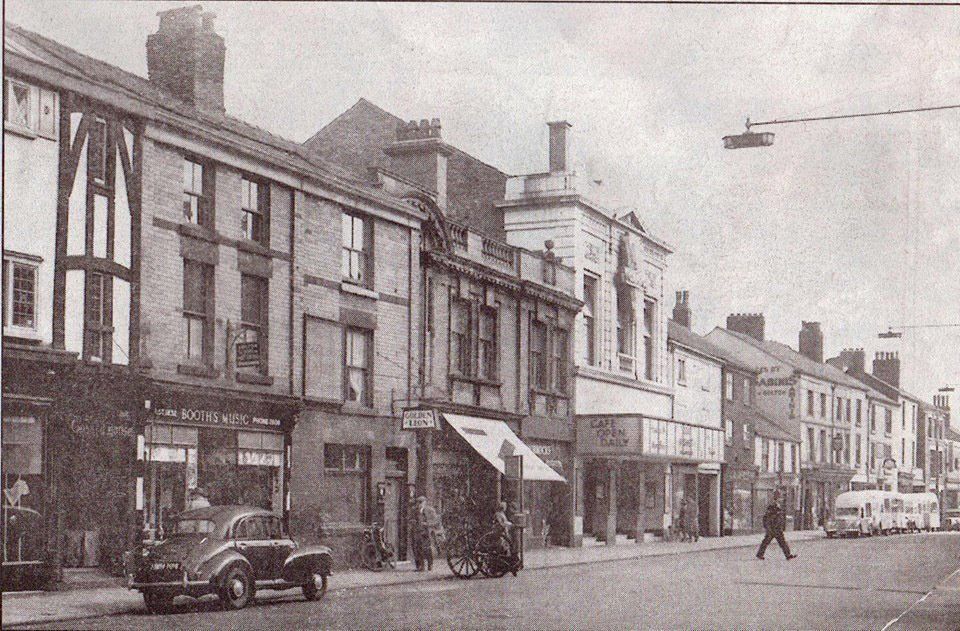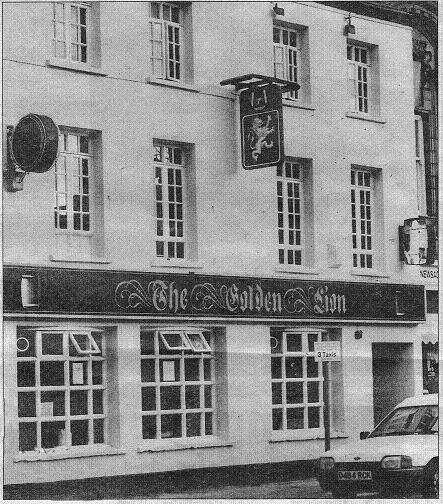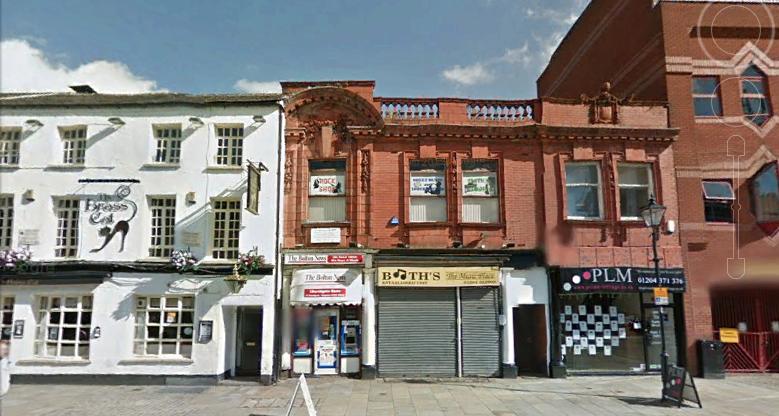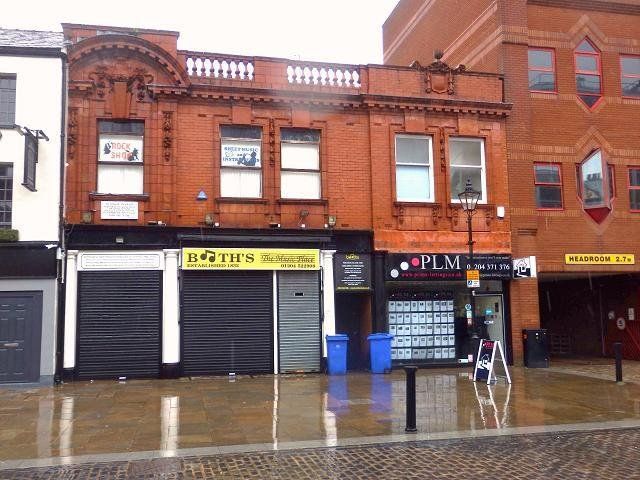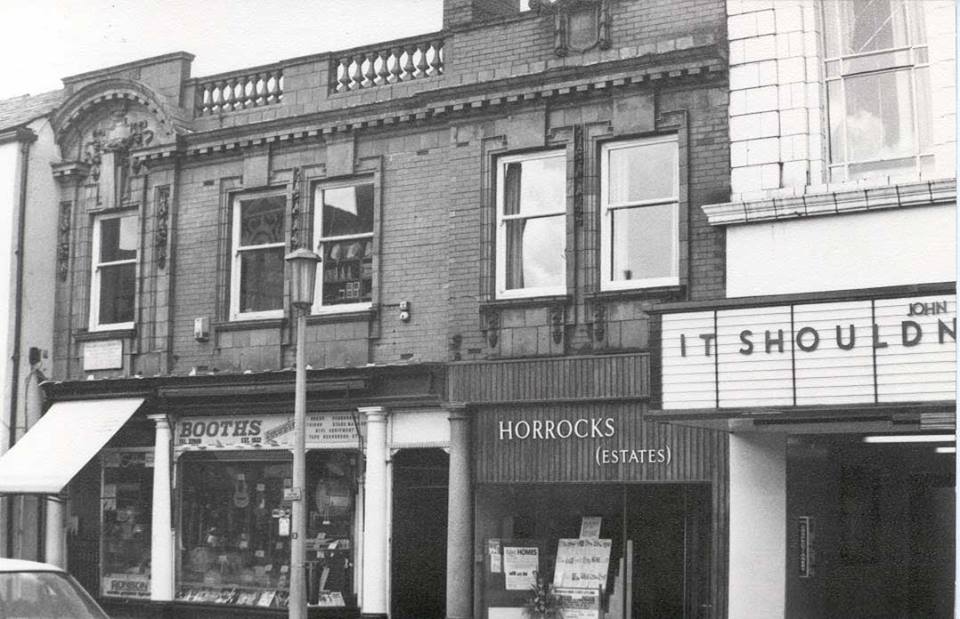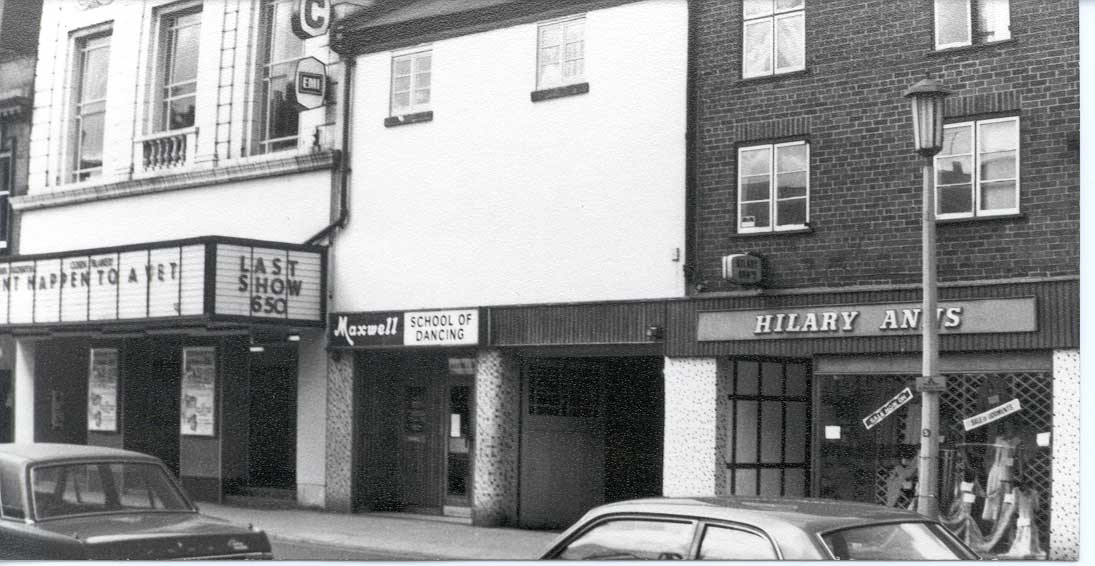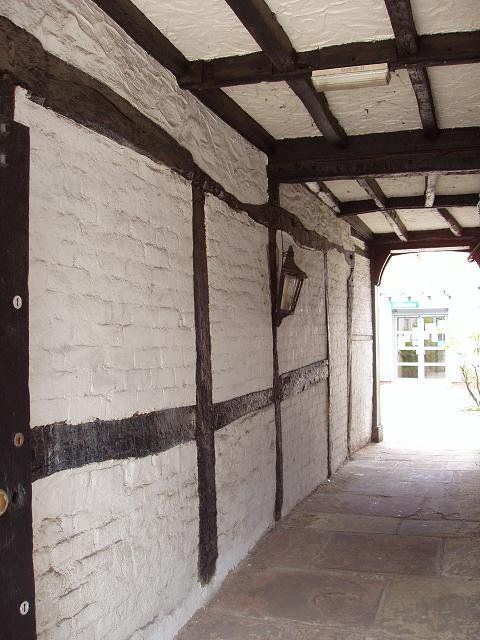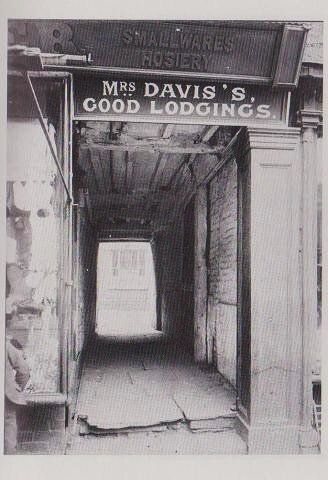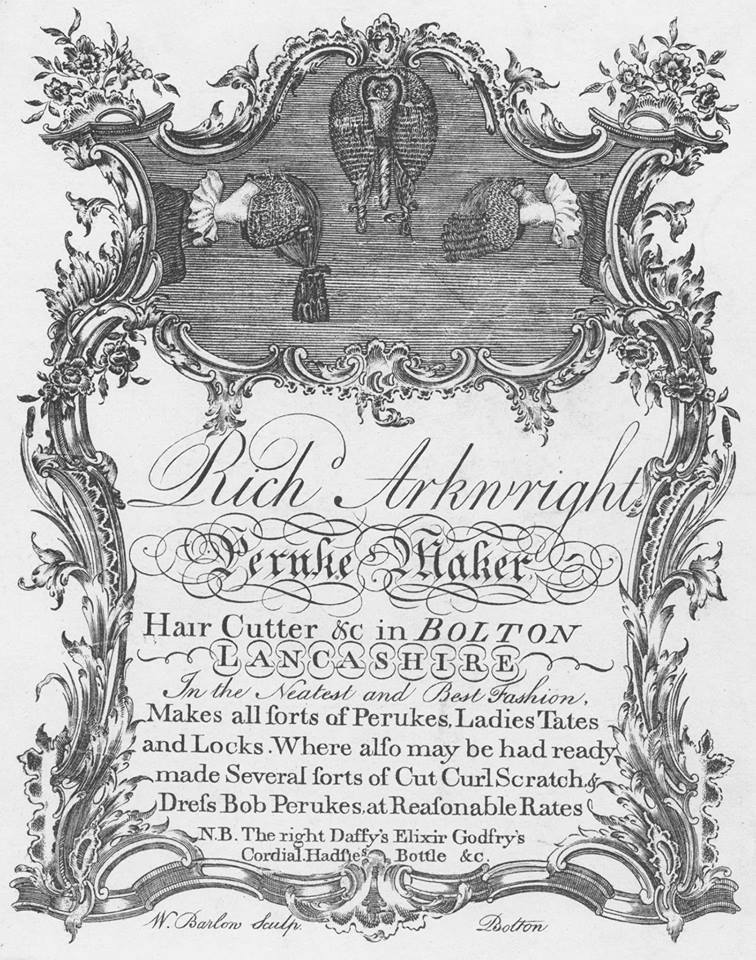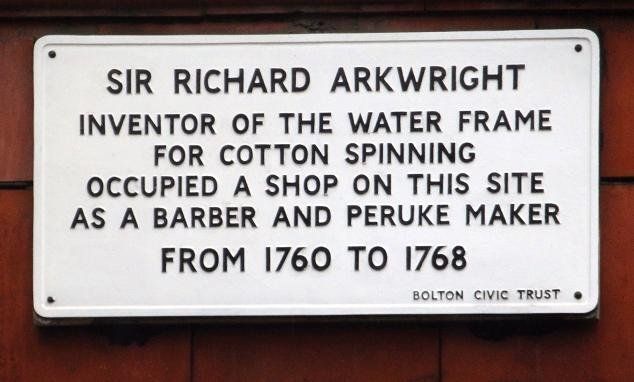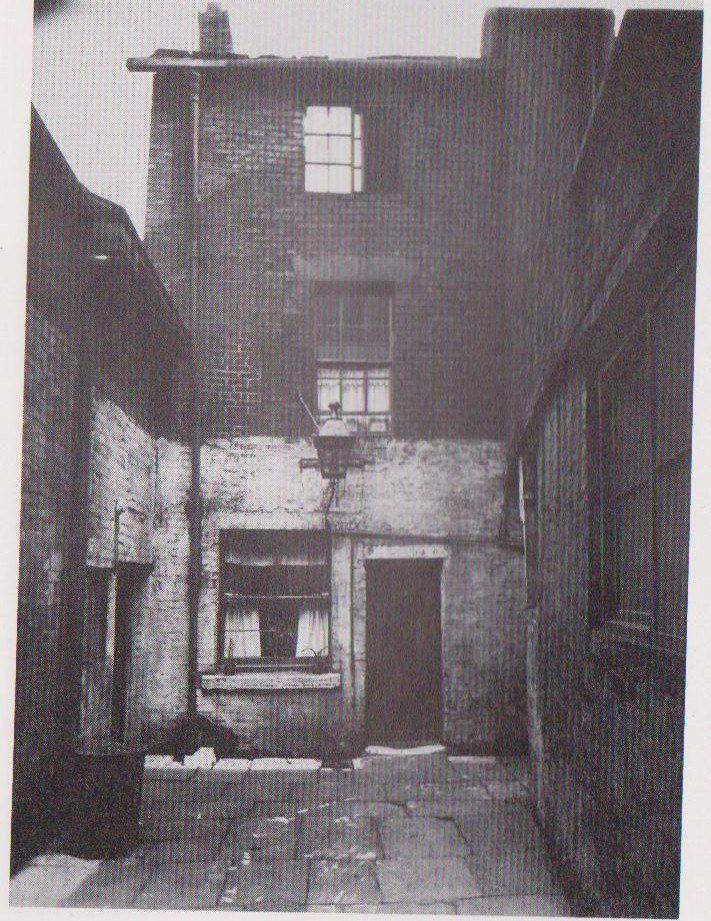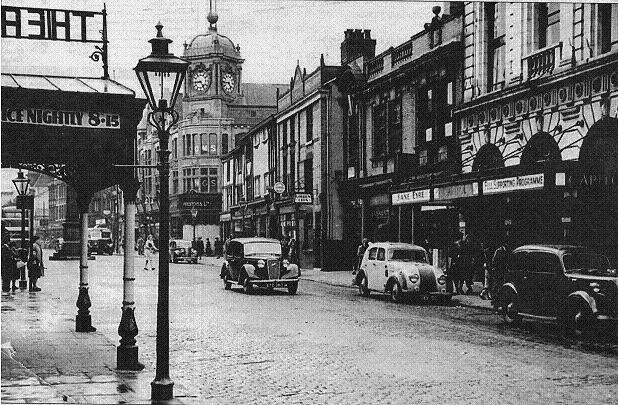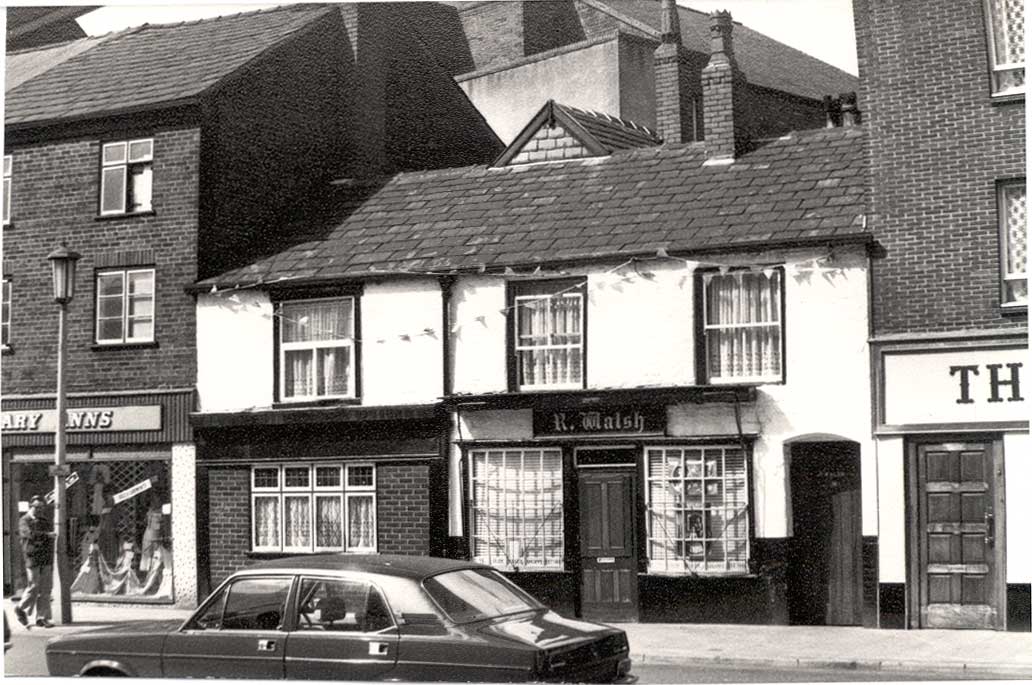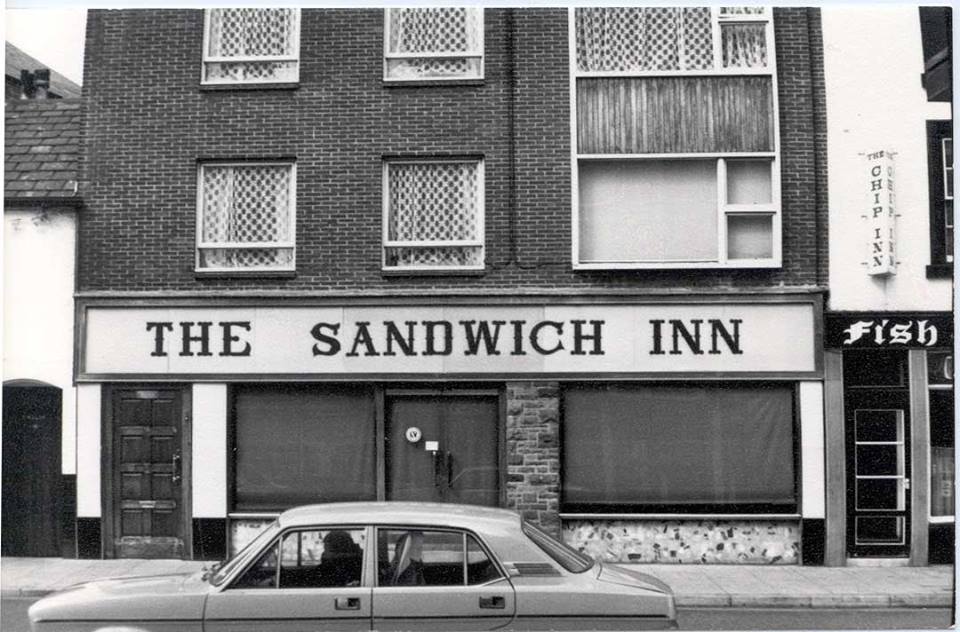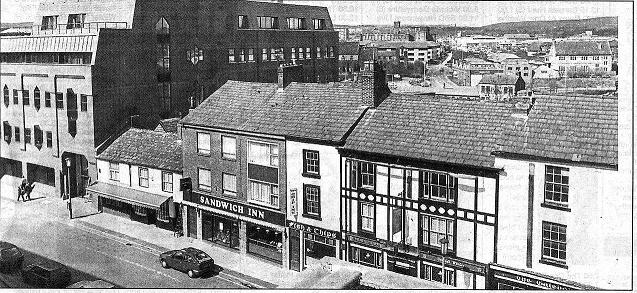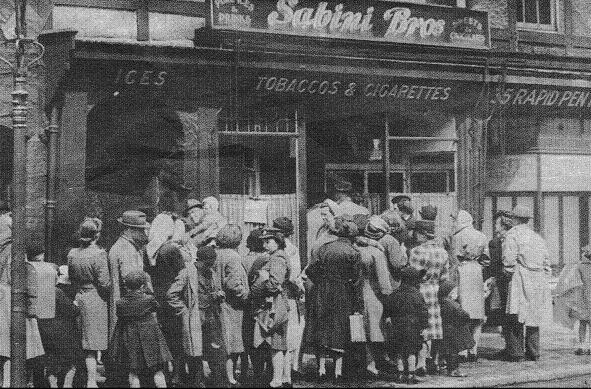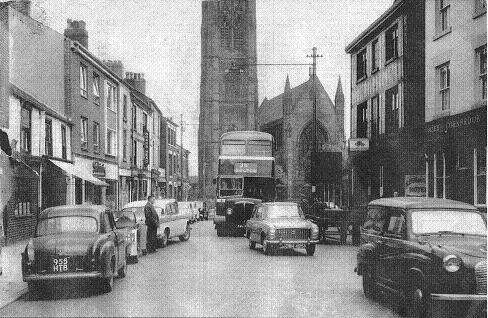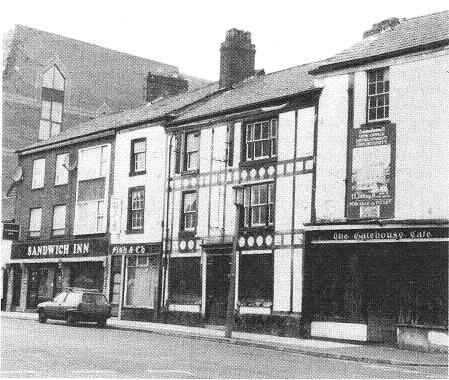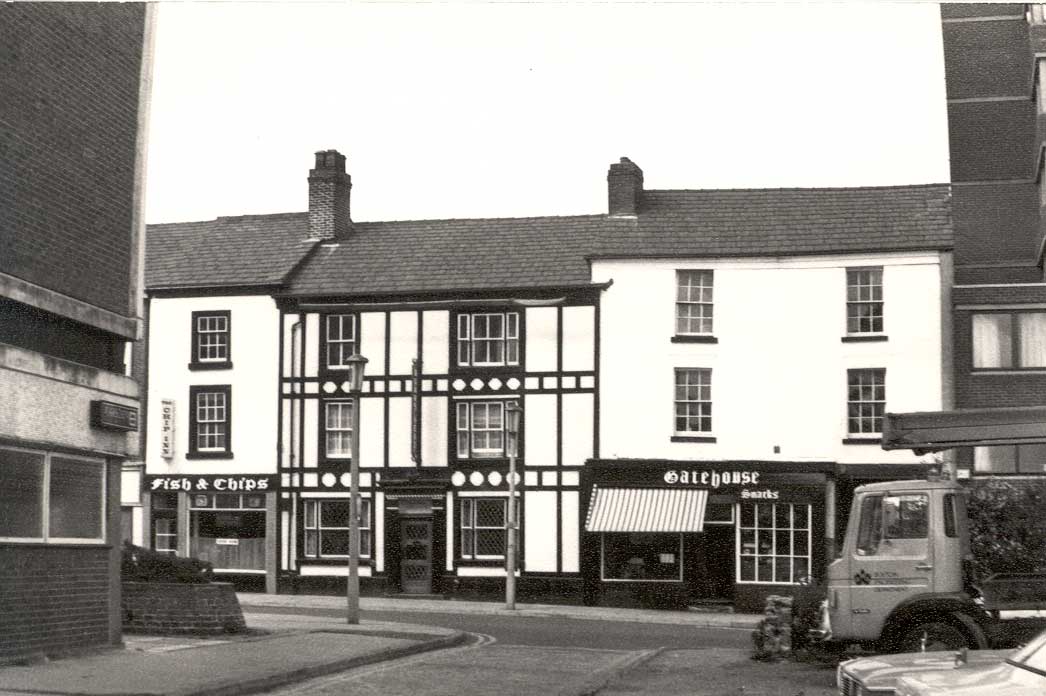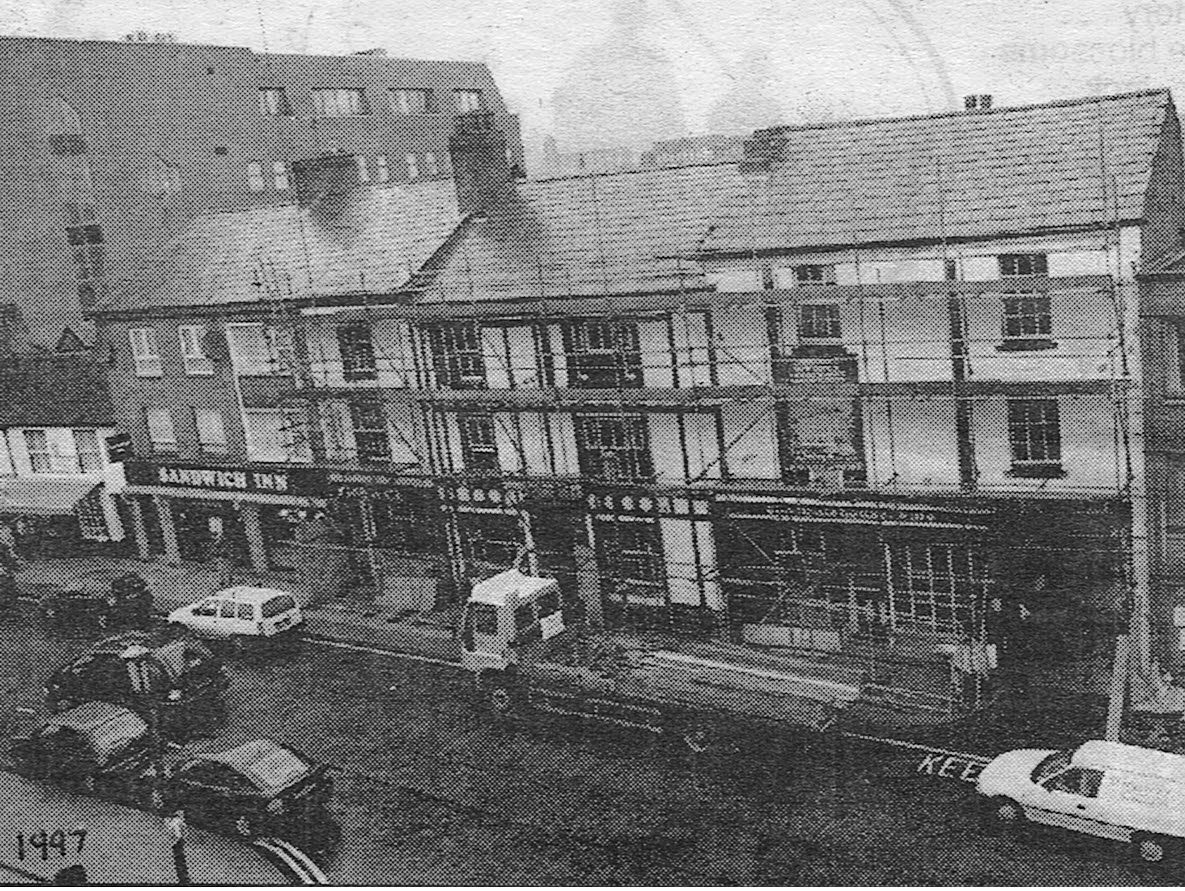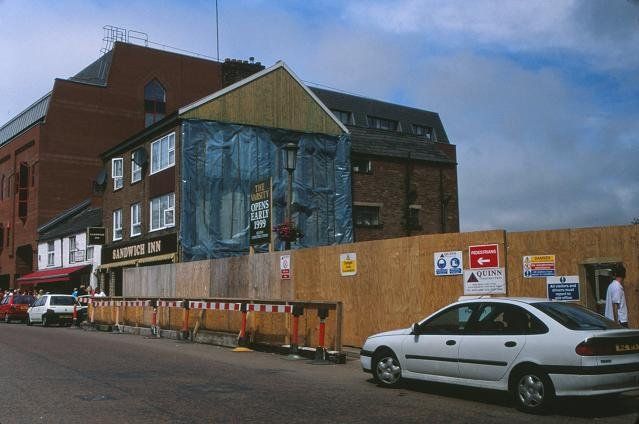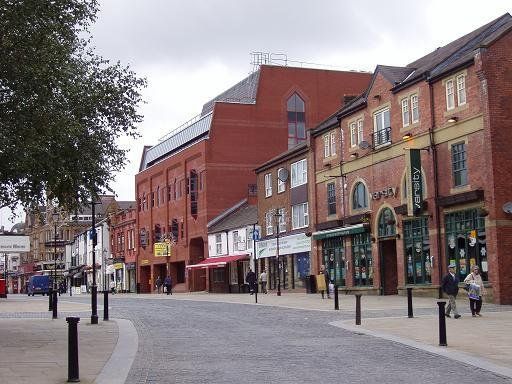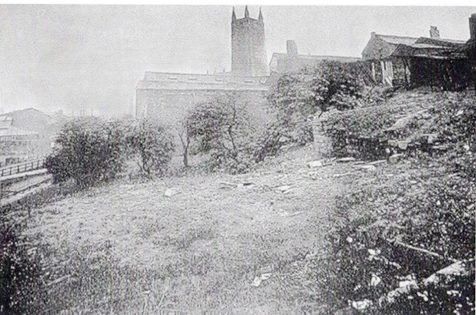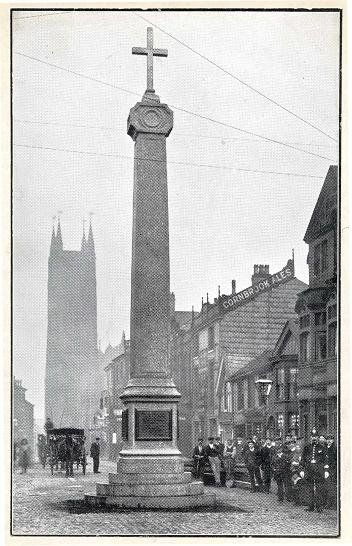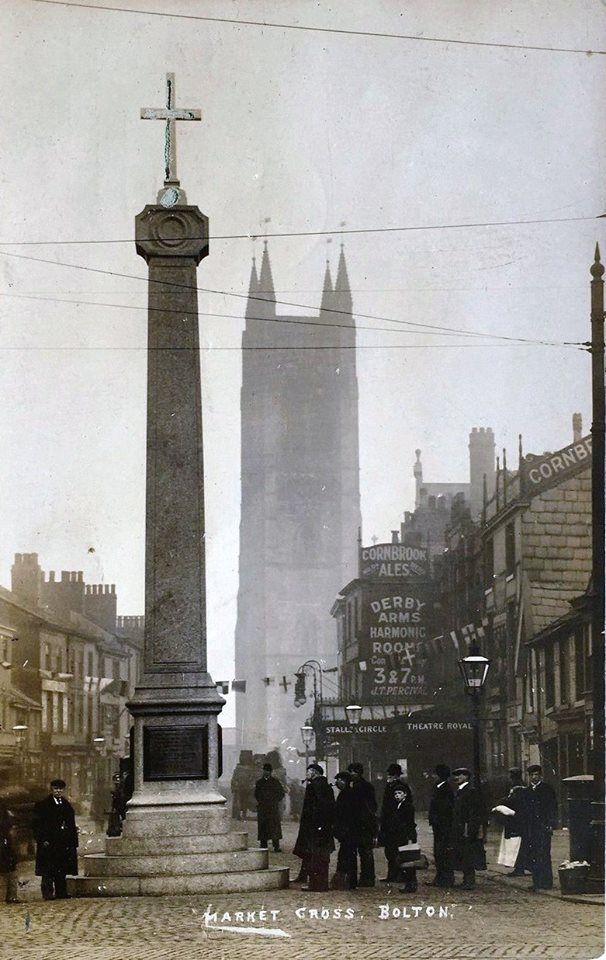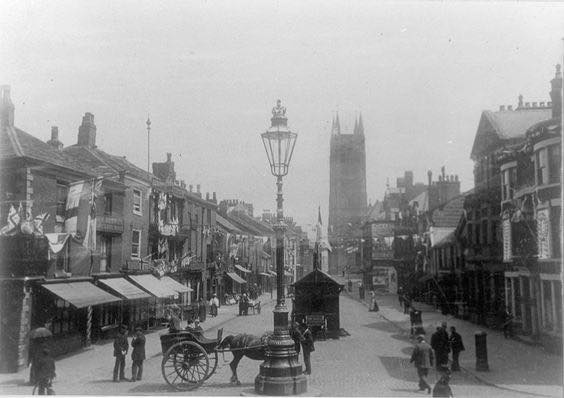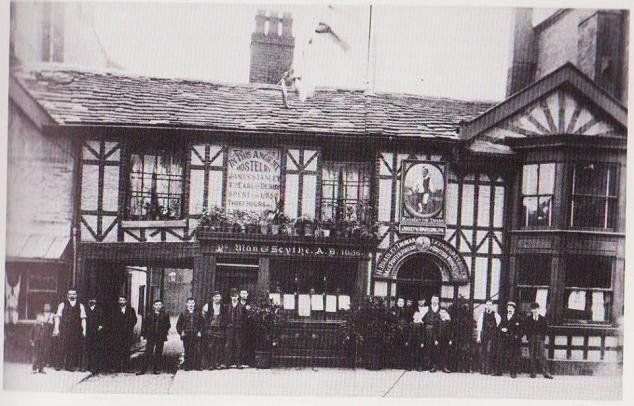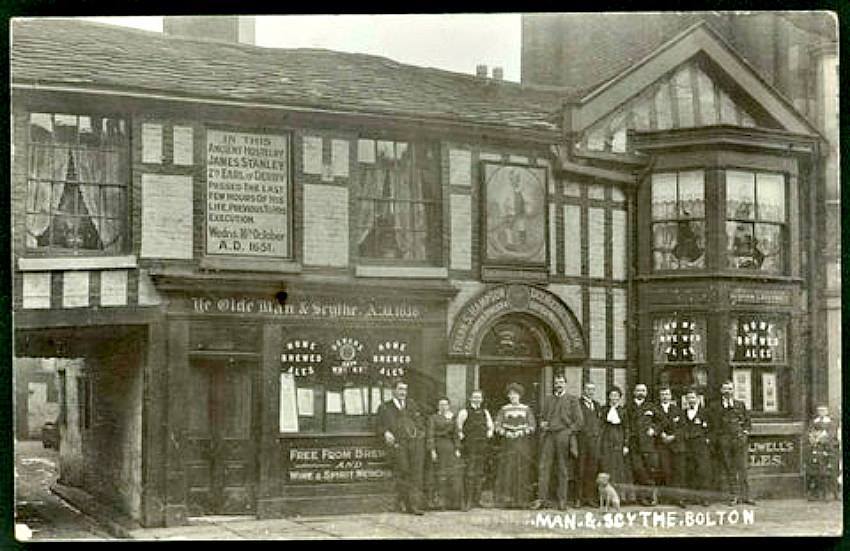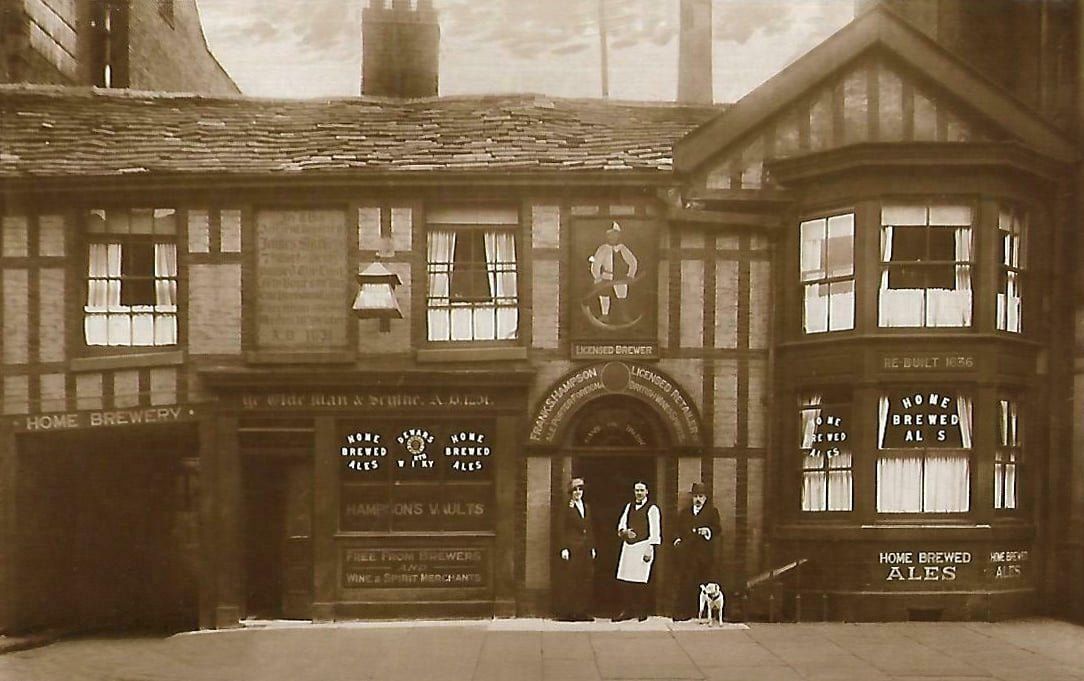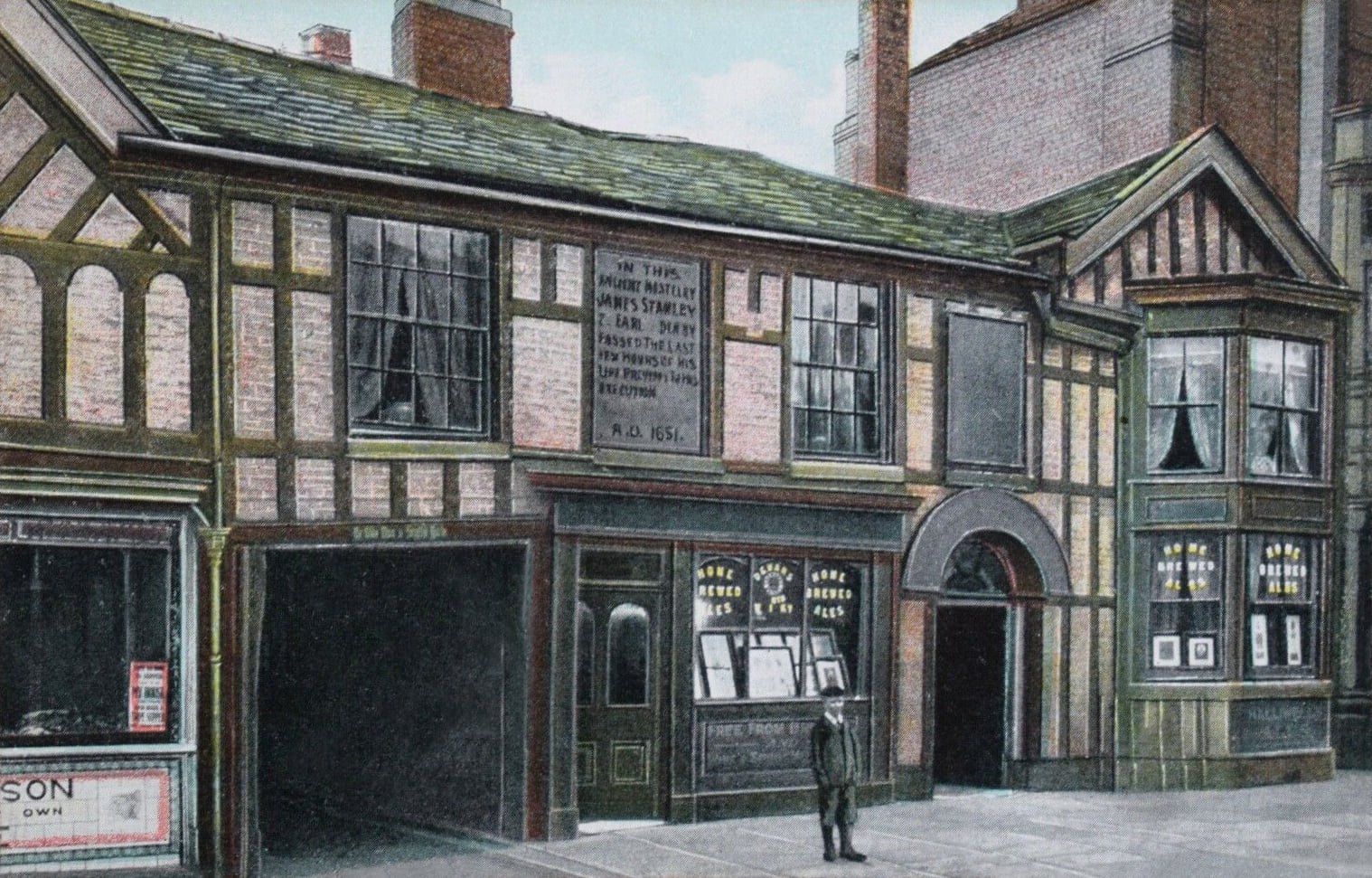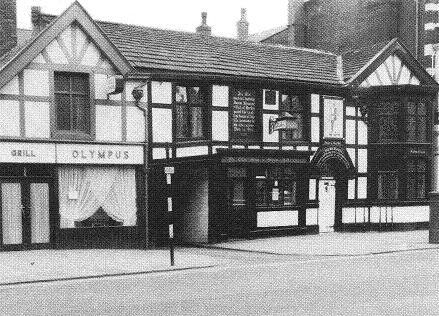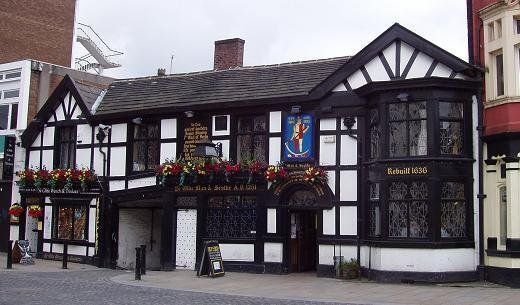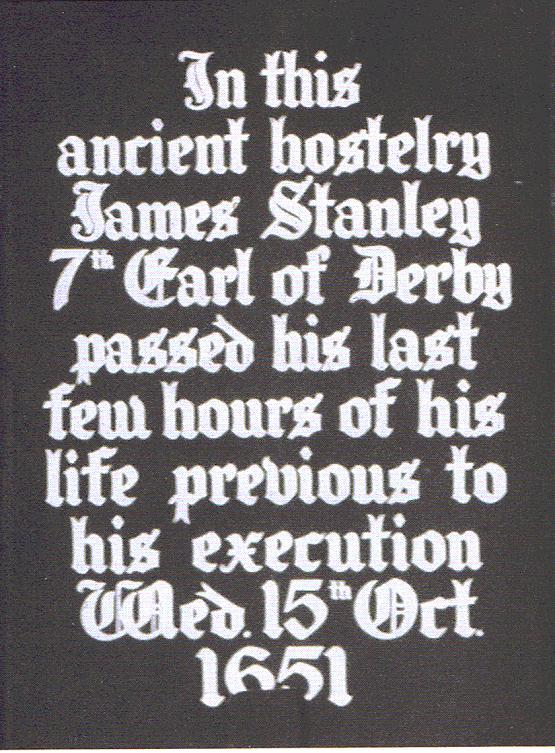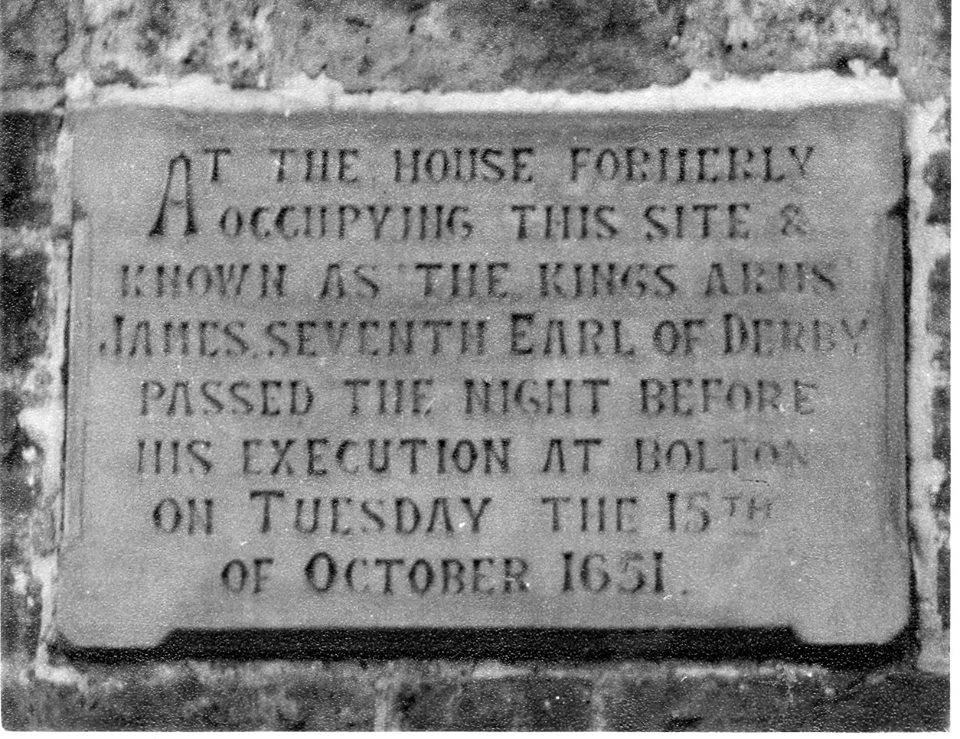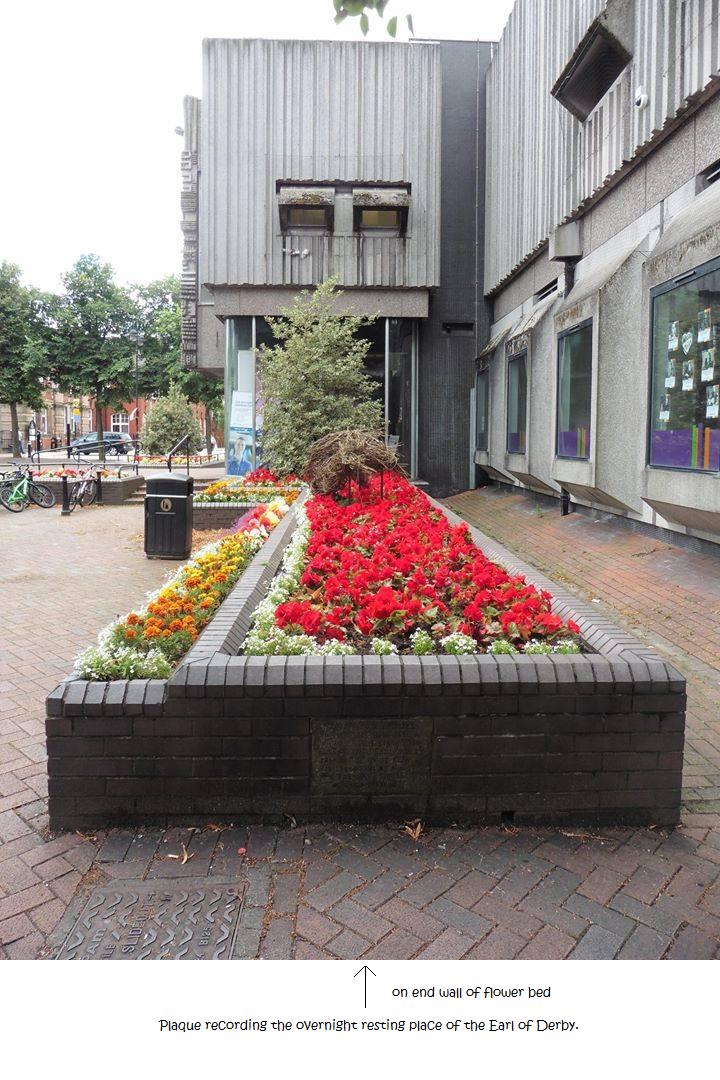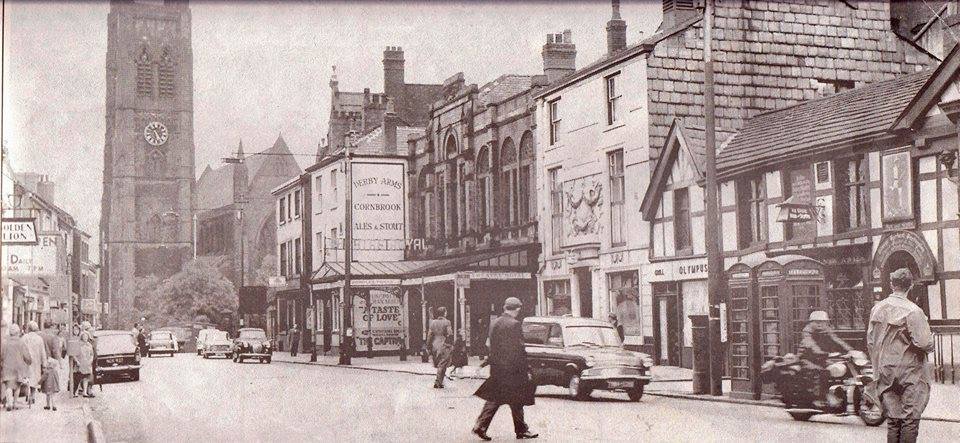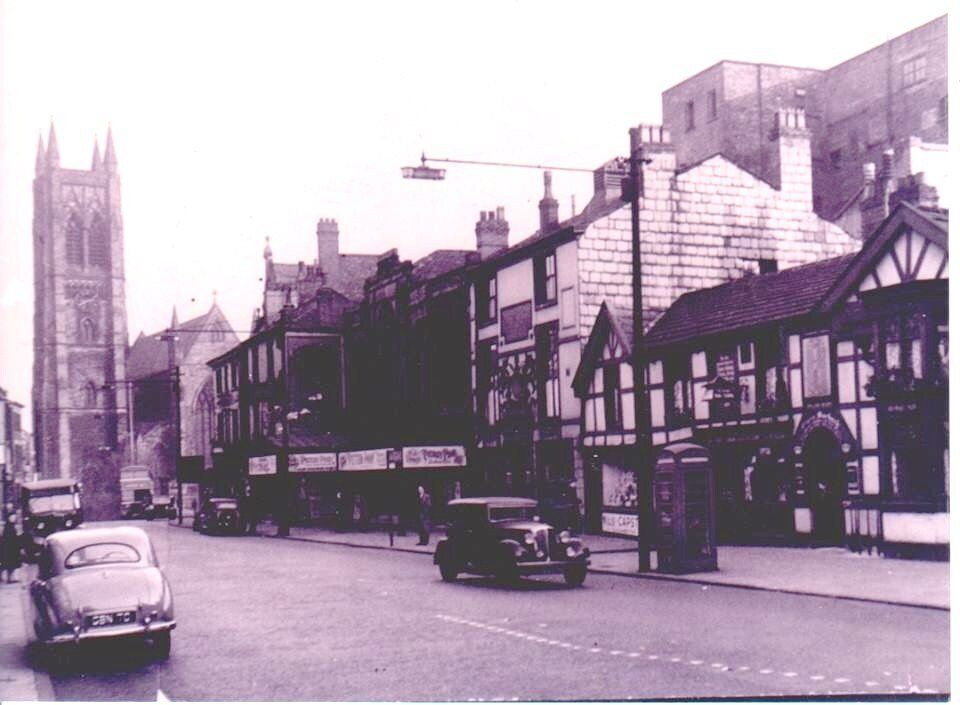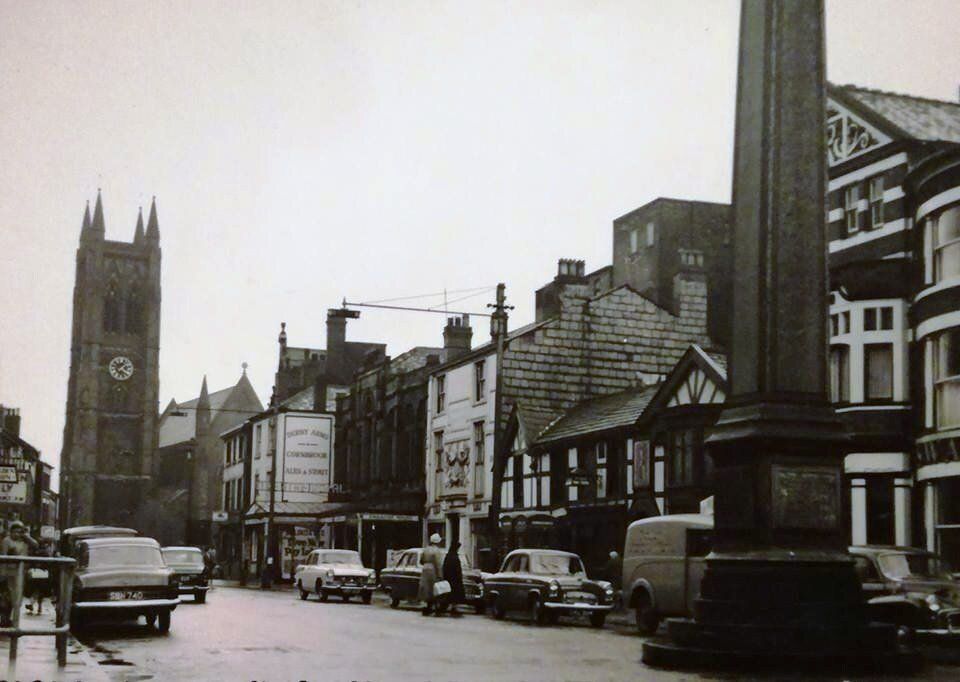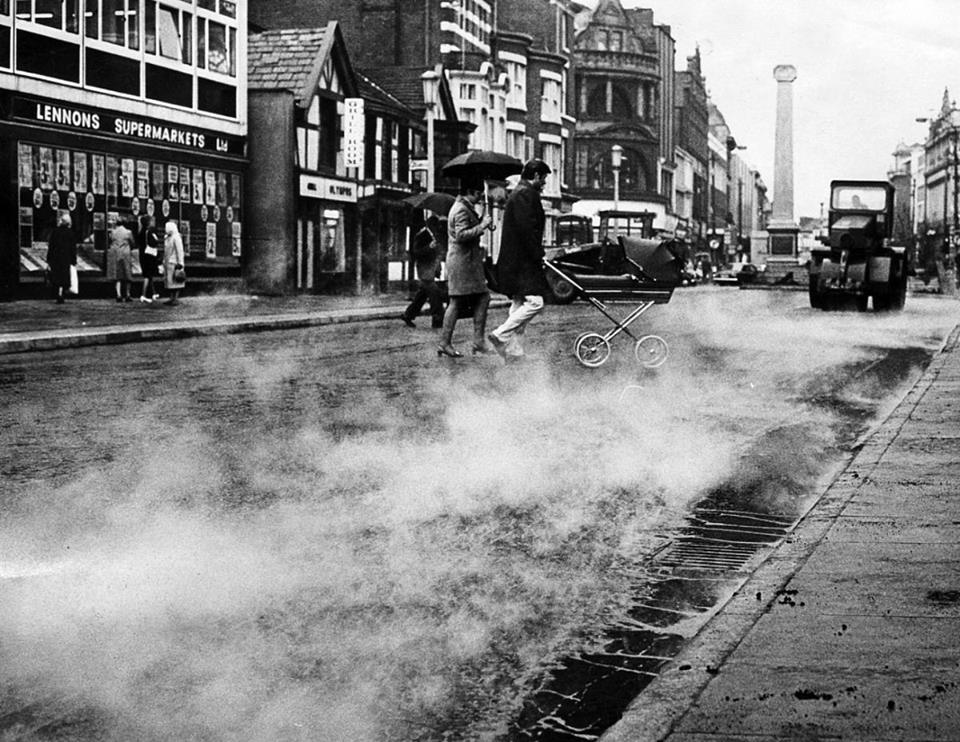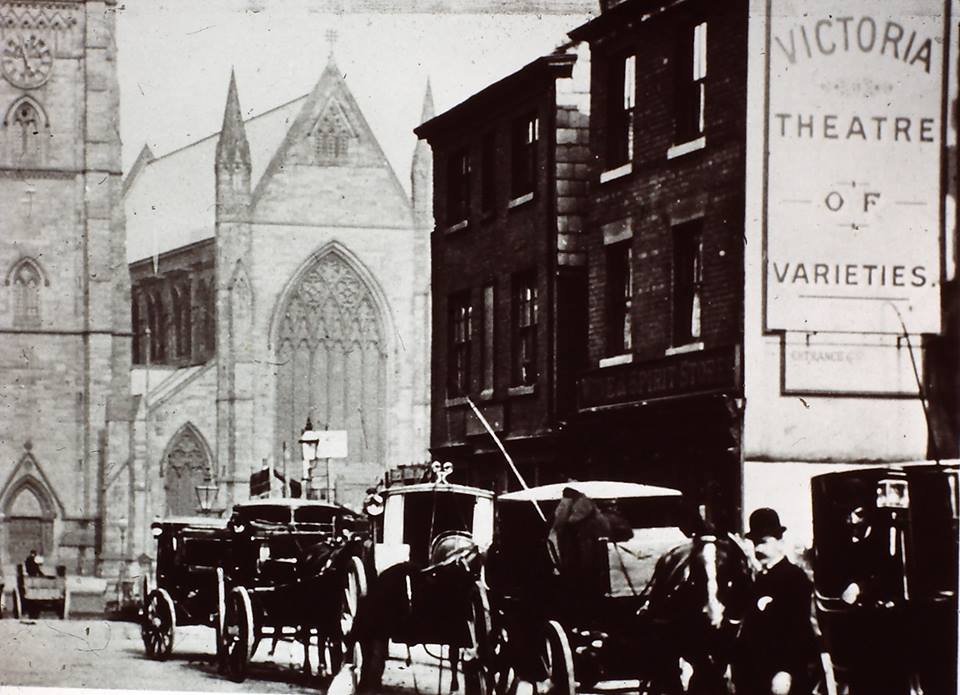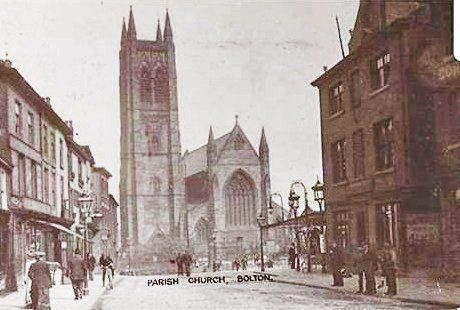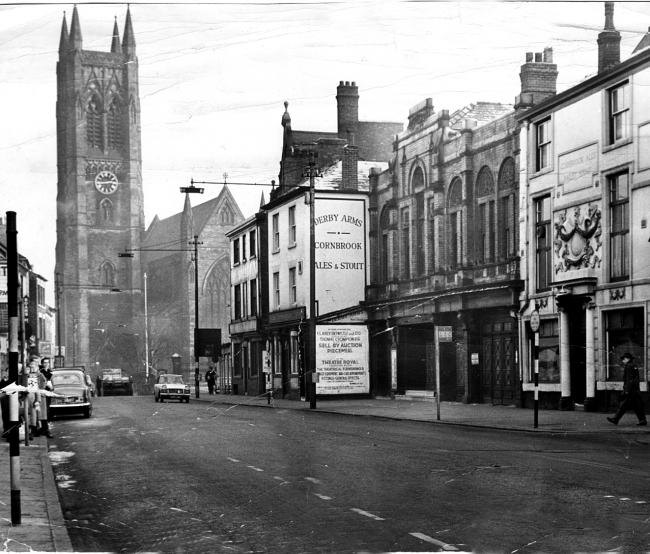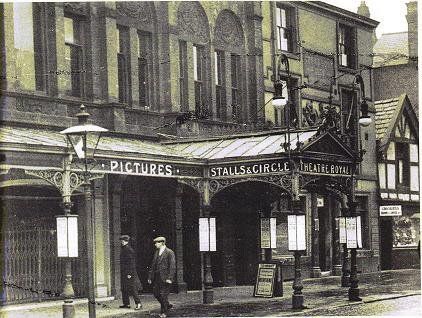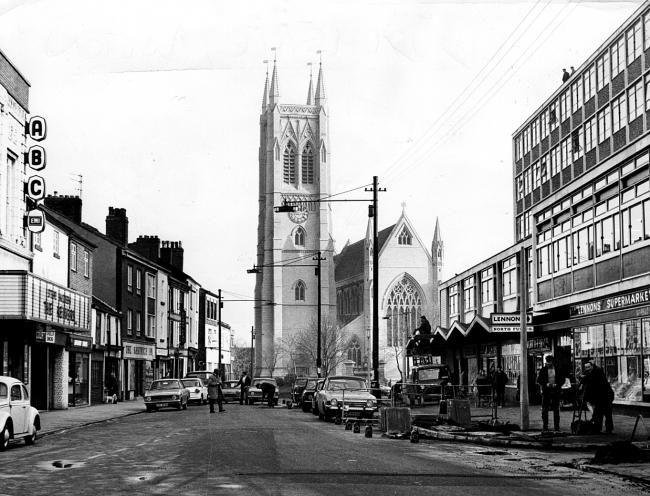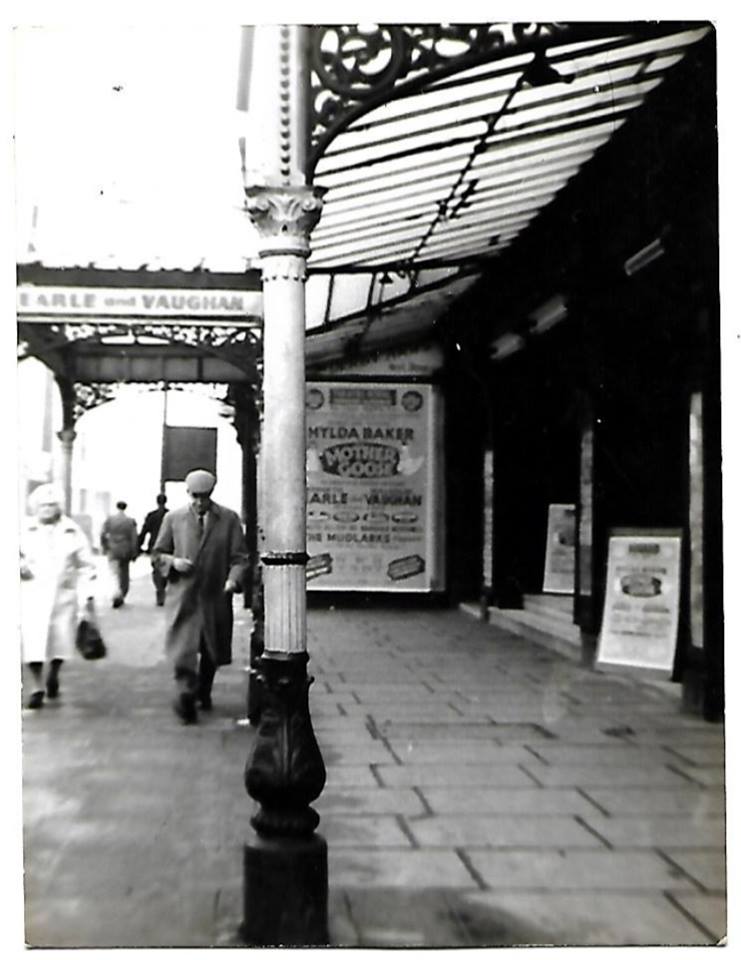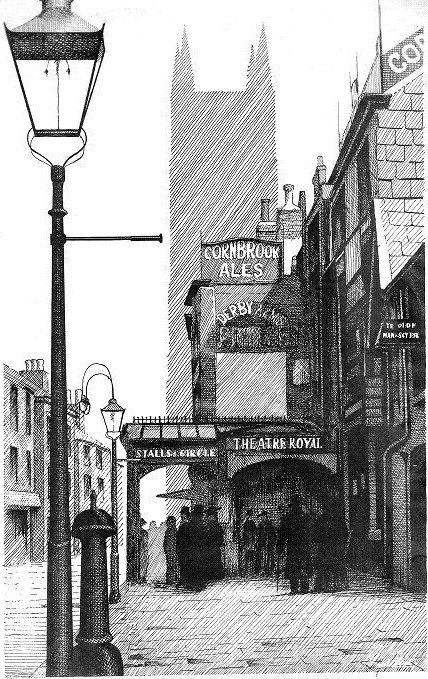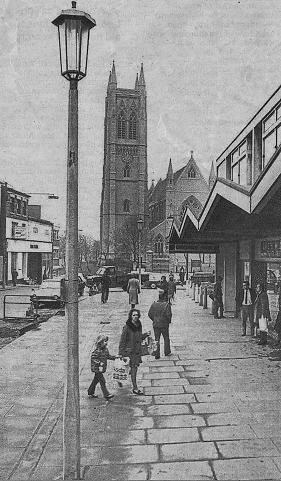15 Churchgate
Churchgate 1952 A picture from the Bolton Evening news. This is how most people of a certain age remember it. Swan. Old Man and Scythe, Bush, Legs o' Man, Golden Lion pubs, Capitol cinema, Theatre Royal and Grand Theatre with the Parish Church standing grandly at the end of the street. Development since then has been, to put it kindly, rather unsympathetic to this ancient centre of Bolton.
To see pictures full size, click on a picture, navigate with<> \\oom with + exit with X
1 1905 posted on Facebook by Peter Lodge. On the left we have Umbrellas and the building that Preston's move into, then we see the quoins on the corner of Vose's. On the right we see a cabbie's hut, the near wall of the Derby Arms and the canopy of the Theatre Royal. We see the Old Man and Scythe but only because we know it is there; the Swan is clear enough The tram heading for Chorley New Road seems to have a full upper deck. Extreme right we have the fustian warehouse now housing shops. Above it appears to say CASH CLOTH
2. 1907 David Whenlock's Postcard. The Umbrella shop is advertising Ladies' Bonnet Boxes.
3. 1907 Churchgate, from the Swan Hotel corner towards the Parish Church, note the tram lines and the cabbies’ shelter which was removed around 1909. Theatre Royal canopy is visible. No market cross which was erected in 1909. Hope Bros shop occupies the corner.Across the corner window it says Portmanteaus. At this time the corner was known as Hope corner rather than the Swan corner or Preston’s corner. Note that there are no exposed beams and no real or fake half timbered effects on the buildings on the left. Note the fourth frontage along, with the sign board on the roof and what looks like a balcony, which will be mentioned later. There are a surprising number of people around, a large group formally dressed. Something is going on.
4. picture posted on Facebook by David Whenlock
Note that the Princess Cinema is where we expect to see the Theatre Royal.
It was originally next door to the Theatre Royal.
In 1928 the Theatre Royal was reopened but seems to have been extended and taken over the Princess Cinema. I assume that the Princess Cinema ceased to exist as an entity from 1928 and certainly this is the only photo I've seen with it on.
So the photo must be at least earlier than 1928.It would appear that the Princess Cinema was there from 1913 when the defunct Victoria Buffet pub was incorporated into it. (Peter Lodge)
The picture includes the Market Cross (so after 1909) and the cabbie's shelter has been removed. Churchgate was wall to wall pubs. Swan on the corner, then the Man and Scythe - we note it is not black and white mock Tudor - the Bush (might have been the Star at that date), the Derby Arms and the Legs o' Man.
September 2009 (C) WDC
Similar view but with bland modern buildings on the right and an insensitive red blob on the left. Capitol and Theatre Royal long gone.
The plethora of black posts does not help the view.
September 2009 (C) WDC
Close in to remove the black posts.
Immediately beyound the red blob is the tiny little Old Pasty Shop with a white upstairs and a red window awning.
Again, the Churchgate we remember. the date is not known but we can make out the Henry Barrie shop at bottom left and this was registered in 1951. The cars would indicate a date little if any later than this. The sign board on the roof of the next building to the right is denoting it as the Red Lion, though at ground level we find that the left side of the building is occupied by Booths Music whose name can be seen on the blind. The bright white frontage is the Capitol Cinema and three buildings to the right is again the tiny Pasty Shop.
The corner with Bradshawgate at bottom right is part of the Swan Hotel.
David Whenlock postcard.
The Capitol on the left is now the ABC.
The modern buildings on this side have not yet been built.
Churchgate is still a through road to Bury.
The picture is dominated by the modern buildings on the right.
Plaques on the four sides of the Market Cross plinth give some details of the history of Bolton. The 1337 date and the actuality of the Flemish settlers is in considerable doubt. 1513 quotes "Lusty lads from Bolton i' th' Moors (Battle of Flodden Field)"This event is commemorated by the arrow on the Bolton Coat-of-Arms.
Click and navigate as usual
probably 1930s
Churchgate - Golden Lion on the left, though half of its frontage is occupied by Booth's Music, Capitol cinema though no name is visible, look at that chimney! Sabini's, On the right the Theatre Royal.
1938 Churchgate
We see at left the Golden Lion before its extension into the whole building, Booth's Music still occupying the left part of the premises. Then a more recent Terra-cotta building which we will see later and the Capitol Cinema (opened 13 February 1929, became ABC August 1962, closed as a cinema October 1977, replaced by Stone Cross House in 1991). The lowest building is the Pasty Shop. Almost at the end of the block a downward spelt GARAGE is National Benzole.
The Parish Church is a feature of course, then returning on the right the Derby Arms which hosts the RAOB, the Theatre Royal, the Bush Hotel and the Old Man and Scythe.
probably 1930s
Churchgate - Golden Lion on the left, though half of its frontage is occupied by Booth's Music, Capitol cinema though no name is visible, look at that chimney! Sabini's, On the right the Theatre Royal.
1939 Churchgate from Whitehead's roof
The next few pictures look in more detail at the north side of Churchgate.
Date not known. The classical view of the Market Cross and Preston's looking onward into Deansgate.
We see the fake black and white on the first four premises and over the Gaskell Court entrance then Booth's Music to the left of the Golden Lion. The posters in the windows are not clear but suggest that Booth's are about to move a few doors to the right (from number 11 to number 17) - which happened in 1962.
Similar picture but date is May 1953 and we see decorations being put up for the Coronation of Queen Elizabeth II.
Two features of this picture are the Preston's building and towards the right a rather fine building with ornate balconies which in 1890 had a sign board above the gutters proclaiming “ Taylor, Builder” but now indicates “Derby Building” The centre of the sign board depicts the elephant and castle which has been for many years a symbol of Bolton. One occupant of this building is Bolton's Temperance bar. Gaskell Court is at the bottom right of this building.
Pity this was not retained though it is just a new front on an old building like the one to its left. Some time later it was rebricked and then had fake Tudor timbering added
The shop on the corner is UCP, then note that we have Beswick's which survived into the 1960s.
Good picture of the cabin with the horse cab.
May 2015 (C)WDC
Gaskell's Court with to the left of it what had been that frontage of cast iron and glass, now plainly bricked and whitewashed with mock Tudor added over the alley way to the court.
The Golden Lion has also had a bit of a make-over and is named The Brass Cat which people had been calling it for the previous 50 years.
At some point in the past it had been called the Bear's Paw and is now (2020) the Churchgate.
c1890. At left the ornate cast iron and glass frontage at this time headed by a sign reading Taylor Builder with the Bolton elephant at its centre. At bottom left is the Opera Cigar Stores. At the right the shop appears to sell clothes and in the upstairs window it says "Ladies and Childrens....". The board above appears to say Furnisher, then Smallwares, Hosiery.
Gaskell Court is surmounted by a sign "Mrs Davis's Good Lodgings". (picture at right).
The buildings which contained the Golden Lion are here quite clearly two separate premises. At number 11 we have "Booth's Musical Instrument Depot". We note James Booth late. Presumably the business was already long established by the date of the photograph. At the right the single fronted Golden Lion Hotel run by E Hamer, Licensed Retailer of Foreign and British Spirits, Wines, Ale, Porter and Tobacco. E is Elizabeth, a widow born in Lincoln.
Next on the right we have an ancient building housing W. Mandy(?) Fashionable ? & Hatter(?) (Outfitter?). This had been the shop of Richard Arkwright, Peruke (wig) maker and barber from 1755. Note on Arkwright at foot of page.
The two buildings to the right of the Golden Lion were replaced by the striking terra-cotta building which still stands.
The pair of buildings have now been refaced and together are surmounted by the Golden Lion sign. Booth's however continue to occupy at least the ground floor on the left. The terra-cotta building to the right has already replaced Arkwright's shop at this time (mid 1920s?). Booth’s moved from here, number 11 to number 17 in 1962. The pub extended into the shop premises shortly afterwards. Picture from Gordon Readyhough’s book.
"The Love Parade" is a 1929 American musical comedy film directed by Ernst Lubitsch and starring Maurice Chevalier and Jeanette MacDonald, involving the marital difficulties of Queen Louise of Sylvania (MacDonald) and her consort Count Alfres Renard (Chevalier). Despite his love for Louise and his promise to be an obedient husband, Count Alfred finds his role as a figurehead unbearable. The supporting cast features Lupino Lane, Lillian Roth and Eugene Pallette. (more below)
The wooden beams in the walls of the passage to Gaskell's court are almost certainly of considerable age, perhaps 16th Century.
The Music Tavern was situated on Gaskell’s Court and although it was only a pub for perhaps 20 years or so in the nineteenth century it became one of the town’s most notorious beerhouses. It grew out of a lodging house on this, one of the many courts that led down tiny alleyways off the main streets of Bolton. By the 1860s the pub was known as the Music Tavern and it was being run by one of Bolton’s most notorious characters – Isabella Dewhurst.
1959-62 The sign above Booths Music and the Red Lion has been removed but was there in 1959; Booths is in its traditional place but it moved in 1962. We see Gaskell Court; Booths Music, Golden Lion with a single frontage; the terra-cotta building; Capitol Cinema but it may have an ABC sign and has a much more sensible chimney than on a previous picture; Pasty Shop; Sabini’s with a line of icecream vans; Boar’s Head etc.
1986 The Golden Lion now extended to the left into what were the Booth's Music premises.
Google Street view 2014
What has been referred to above as the terra-cotta building. This appears to be half a building, the arch at the left hand end should be the centre, and even this arch is not quite complete. It seems that the instigators of the terra-cotta building built in anticipation of completing the left hand side in place of the Golden Lion and Booth’s Music, but were then unable to do so. The Golden Lion later extended in the other direction to take over Booth’s Music in 1962 which moved to its position in this picture.
September 2017 (C)WDC
The Golden Lion in its latest format.
September 2017 (C)WDC
Rock Shop in the top left window is quite recent.
Just below that is a sign that has been there for many years recalling Arkwright's Barber's shop. Pity it makes the disputed statement about him being the inventor.
Below that is a much more recent sign telling about Booth's Music.
The terra-cotta building. The newsagents in the small shop under the "central" arch has a plaque commemorating Arkwright's barber's shop on that site. The building has the Golden Lion on the left and the Capitol cinema on the right. This building still stands but the cinema does not.
"It shouldn't happen to a vet" was released in 1976 and was a sequel to "All Creatures Great and Small" released the year before.
This picture is from the Bolton Museum collection. c1976
Another picture from the Museum Archives which completes the previous picture c1976.
The cinema, then we have Maxwell School of dancing and Hilary Ann's ladies' fashions (which later moved onto Deansgate). No doubt many fond memories of both from many Boltonians.
The cinema and these two buildings were replaced by the new large red brick building Stone Cross House which is imaginative and not too ugly but is quite out of place on Churchgate.
c1930 Wow do you remember cinema queues like this?
A glance back along this side of Churchgate in 1959. The wooden boarding on the roof of the Golden Lion is there and stretches over the double frontage though the building to the left is a shop at street level. The sign over the shop includes the word “school”. The picture is not clear enough to see but Booth’s is still to the left of the Golden Lion at this time.
Another picture from the Museum Archives which continues previous pictures c1976.
We continue past Hilary Ann's to the two small cottages the right hand one of which is Walsh's Ye Olde Pastie Shoppe. To its right is the Sandwich Inn which was previously Sabini's. The two cottages still stand as also do the two premises which were combined as the Sandwich Inn. The buildings further to the right (east) have all been replaced.
Continuing along the row with Bolton Archives.
April 1991 from the roof of the Bolton Evening News office.
Stone Cross House; the Old Pasty Shop totally dwarfed; Sandwich Inn (ex Sabini's); Chip Inn; the Boar's Head; the Gatehouse cafe.
Sabini’s was here on Churchgate from the 1930s until it became the Sandwich Inn in 1970 which continued in business until 2002
The Sabini Brothers came to Bolton before WWI and started an icecream business in Little Lever. They moved to 33 Churchgate in the 1930s running an “American Temperance Bar”. There is no evidence of that on this picture the shop being Sabini Brothers selling Ices, Tobacco and Cigarettes but also sweets and chocolates. We do not know the reason for the queue.
We note that next door at number 35 is the Pen Hospital. After the war Sabini Brothers expanded into number 35 and became Sabini’s without the Bros as which they traded until 1970.
A view onwards probably early 1960s. note the Pasty Shop, Sabini’s (not Bros, in a double shop), x, Boar’s Head, y, z, National Benzole garage. Churchgate was of course the main road to Bury.
On the right the Legs o' Man and the Derby Arms.
between 1992 and 1998 Churchgate,
Stone Cross House has replaced the Capitol Cinema, Pastie Shop just out of sight, Sandwich Inn, Boar’s Head now closed, the Gatehouse Cafe which has a sign advertising the new office block development opportunity. The Sandwich Inn building (along with the Pasty Shop and the shop to the left if it) still stand on Churchgate. Everything to the right has been replaced.
c1976 continuing the series from Bolton Archives
Fish and Chips, Boars Head, Gatehouse snacks from Paley Street alongside Newspaper House, the home of Bolton News before its move to Wellsprings in Victoria Square.
The Boar’s Head was built in 1721 and demolished 1998 (closed as a pub 1992).
Gary Sykes notes that the Boar’s Head (and the rest of the block I guess) was beyond saving. It had been slipping towards the river Croal for years and on the upper floors there were large gaps between floors and walls. Nevertheless the distance from the back of the pub to the top of the bank above the Croal was quite large so there may be some little doubt about "beyond saving".
1997 (1998?) Churchgate, We see the end of the new building(Stone Cross), the Pasty Shop, then the site of Sabini’s – now the Sandwich Inn, fish and chip shop, the now closed Boar’s Head (behind the lorry cab), Gatehouse Cafe. The scaffolding is probably to assist with the demolition of this block.
Between Churchgate and the River Croal.
This is the location of the cock pit behind the Boar's Head.
August 1998. (C)WDC
Demolition complete, hoardings surround the empty site. The main sign board advertises The Varsity expected to open 1999 not offices.
(C)WDC September 2009
The Pasty Shop is still alive and well, Sandwich Inn has become a Letting Agent, The Varsity is up and running – this is another reasonably acceptable building and its bulk is somewhat more in keeping with its neighbours than the monstrosity to its left. Perhaps it is out of place on Churchgate, but it is the age old problem, how can you modernise in keeping with the older surroundings. In this case perhaps the Boar’s Head should have been retained then there would have been no need to “modernise”.
Below we return to the market cross and look along the south side of Churchgate.
The Market Cross looks newly installed the ground around the base is very disturbed two of the first four men to the right have spades. There is quite a little crowd of onlookers held in check by a bobby. The cabmen’s cabin has been removed. Picture almost certainly 1909.
1953 - Man and Scythe; Smokey Joe’s on the other side of the ginnel from the Man and Scythe, with Capstan sign, tobacco and sweets at the front, a Temperance Bar behind; pub - The Bush Hotel, 14 Churchgate, formerly the Star which in 1840 had a bagatelle room and one of the most popular and attractive concert rooms in the country. After a fire the Concert Room was rebuilt as the Victoria Theatre opening in January 1885 but the Hotel retained its name as the Star. It was sold, along with the nearby Theatre Royal in August 1877.
The Star was rebuilt again in 1886 but by 1900 it had reverted back to being a public house and was renamed the Bush Hotel.
(http://lostpubsofbolton.blogspot.co.uk/)
1897 Churchgate with flags for Queen Victoria's Diamond Jubilee.
The decorated V R can just be made out on the front of the Swan.
One of Bolton's splendid street lamps has at crown on top.
An elegant light weight carriage.
Note the cabbie's cabin.
On the left the fourth and fifth premises have the cast iron balustrades.
More pictures of the decorated Swan on the previous "Preston's Corner" page.
The Olde Man and Scythe, Churchgate click on a picture and navigate.
A pub was apparently built on this site in 1251 and rebuilt in 1636; it is thought that the cellars were retained at this time but nothing of the building above ground. The wattle and daub building was replaced with brick. Part of the pub was destroyed by fire in 1850 and the subsequent rebuilding is essentially what we have today.
The "Man and Scythe" is a mower or reaper with no connection at all with the Grim Reaper. It is the crest of the Pilkington family the story being that an ancestor being hunted at the time of the Norman Conquest disguised himself as a mower and escaped the Normans.
The Pilkingtons owned large tracts of land including Bolton from the early 1300s (that reference should probably be early 13th Century since Man and Scythe is mentioned in 1251) until 1497 (1485?) when the lands passed to the house of Stanley of which was James Stanley, 7th Earl of Derby infamously beheaded here in 1651. The Derby family recalled by Derby Street and Knowsley Street and others were Bolton landowners until modern times. It has been suggested that the Pilkingtons had a manor house on the site of the Man and Scythe. There were a number of branches of the Pilkington family including the glass makers of St Helens.
The notice originally said that The Earl of Derby spent his last three hours in this pub before being beheaded for being on the wrong side in the English civil war and for his part in the massacre, 28th May 1644, of possibly 1500 people after Bolton fell to the Royalists under Prince Rupert on the third attack. The Earl of Derby spoke from the scaffold and denied any part in the massacre. The notice was later amended to read "last FEW hours". It is sometimes believed that he spent his last night, 14-15 October 1651, here but that is not the case.
In the above pictures notice the pattern of black and white is different between picture 1 and the others, the modern pattern being different again. On picture 2 it is obvious that the pattern is painted onto brickwork; it is the same though less obviously so on pictures 1 and 3.
Picture 1 has Man & Scythe 1636. In picture 2 we have the addition of "Ye Olde". In picture 3 the date becomes 1251.
Picture 1, the part to the left of the ginnel appears to be a butcher's shop. In picture 4 tiling below the window suggest that that was still the case.
Picture 1, the story board has ornamental writing for In this ancient hostelry and says "spent the last three hours". In picture 2 this has changed to "few hours".
On picture 1 the landlord appears to be H Bradley Why there is another name Joseph Bradley or Barlow and what the writing is below the picture, I do not know. Pictures 2 and 3 have the landlord as Frank S Hampson and under the picture it says Licensed Brewer.
Pictures 2 and 3 have the words "free from brewer" but Halliwell's Ales of picture 2 is replaced by "Home Brewed Ales" on picture 3 where we also find the words "Home Brewery" above the ginnel.
Only picture 3 has a lamp.
1. Man and Scythe with Olympus Grill to the left of the alleyway replacing the Regent Temperance Bar usually known as Smokey Joe’s. We see the familiar black beams and white infill which were added early in the twentieth century.
2. 27 Sep 2009 (C)WDC the alleyway still exists. Olympus Grill has now been replaced by “Ye Olde Wench and Trinkets” jewellery shop.
3. The sign as it was around 1950/60. In 2009 the lettering was in gold.
4. the plaque in Leigh at on or near the site of the inn where Lord Derby spent his last night.
1 (C) Michael Caine flower bed in front of Leigh Library with the plaque on its near end.
2. 1951, looking back, the Swan overwhelms the Man and Scythe.
3. And one more view, showing the Swan, the Man and Scythe, the Bush and the facade of the Theatre Royal. The Bush closed in 1963 and that pub, the Derby Arms and the Theatre Royal were all demolished for the redevelopment of Churchgate. On the site of the Bush and Theatre Royal was built Lennon's Supermarket, later Kwik Save then Foodsave.
4. Churchgate 1960s? Golden Lion, Capitol Cinema, Legs of Man , Derby Arms, Theatre Royal where the play is "A Taste of Love", Bush Hotel (formerly the Star Inn, demolished 1963), Man and Scythe with Olympus Grill
New Paragraph
3. December 1970. Churchgate is still open to traffic though it looks as if it is no longer a through road. What are people doing in the road? There is also a man up a ladder on the zig-zag roof and a couple standing on the roof of the building. All the buildings on the right have now been replaced by new "modern" buildings, Churchgate House, which at this time houses Lennon's supermarket.
On the left, the Capitol is now ABC. We can see the Pasty Shop and the Sandwich Inn.
We begin the next page with a look around the area of the Parish Church then make our way down Churchbank.
1953 Picture from David Whenlock's collection
No information
Roadworks on Churchgate. The Bush has been replaced by Lennon's Supermarket, later Kwik Save then Foodsave.
The Victoria Theatre of Varieties was opened in 1866 on the site of the old Museum and Concert Hall.
The theatre is a quite large building immediately off picture to the left. Attached to it facing onto Churchgate was the Victoria Buffet (licensed). For a time it coexisted with the Theatre Royal next door to it, closer to us.
The licence lapsed in 1912 and the premises reopened in 1913 as the Princess Cinema. It became part of the extended Theatre Royal in 1928.
The notice is on the wall of the Derby Arms which is separated from the Legs of Man by a narrow Lane.
This picture is likely to be before the Grand Theatre was built in 1894 though perhaps we just cannot see it because of the angle.
The Parish Church was built with its tower in the position it is for visual effect looking along Churchgate.
On the right we have the Legs o' Man then a canopy associated with the Grand Theatre just out of sight round the corner.
1963 BEN picture
The roof of the Theatre Royal canopy has been removed and the poster indicates that the theatre is to be sold by auction.
The Bush Public House at the right.
Above and left, the Theatre Royal in its heyday.
Left:A last look back at the Theatre Royal with the Bush and Smokey Joe's. Picture from Lesley Gent book.
below: drawing by Tim Shortin
"The Love Parade"........
The film was directed by Lubitsch from a screenplay by Guy Bolton and Ernest Vajda adapted from the French play, "Le Prince Consort" written by Jules Chancel and Leon Xanrof. The play had previously been adapted for Broadway in 1905 by William Boosey and Cosmo Gordon Lennox.
The Love Parade is notable for being both the film debut of Jeanette MacDonald and the first "Talkie" made by Lubitsch. The picture was also released in a French-language version called Parade d'Amour. Chevalier had thought that he would never be capable of acting as a royal courtier and had to be persuaded by Lubitsch. This huge box-office hit appeared just after the Wall Street crash and did much to save the fortunes of Paramount.
httpscommons.wikimedia.orgwindex.phpcurid=61468432

